Volkswagen Group: History, Marketing Strategy, and Competition Analysis
VerifiedAdded on 2023/06/12
|21
|4765
|227
AI Summary
This article delves into the history of Volkswagen Group, their marketing segmentation and strategy, competition analysis, and SWOT analysis. The article also discusses the company's management strategy and corporate responsibility.
Contribute Materials
Your contribution can guide someone’s learning journey. Share your
documents today.

Volkswagen Group 1
VOLKSWAGEN GROUP
Name:
Institution:
Course:
Tutor:
Date:
VOLKSWAGEN GROUP
Name:
Institution:
Course:
Tutor:
Date:
Secure Best Marks with AI Grader
Need help grading? Try our AI Grader for instant feedback on your assignments.
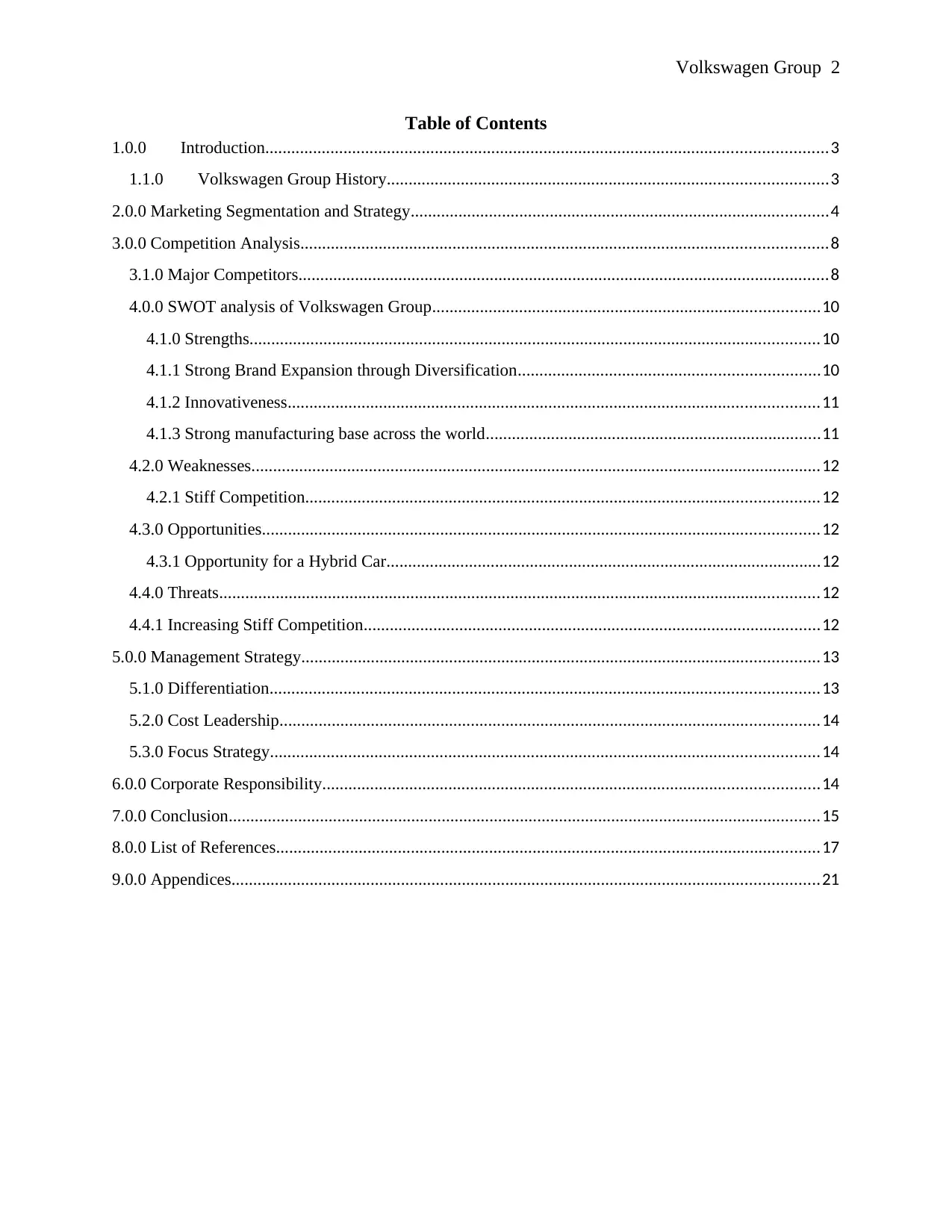
Volkswagen Group 2
Table of Contents
1.0.0 Introduction.................................................................................................................................3
1.1.0 Volkswagen Group History.....................................................................................................3
2.0.0 Marketing Segmentation and Strategy................................................................................................4
3.0.0 Competition Analysis.........................................................................................................................8
3.1.0 Major Competitors..........................................................................................................................8
4.0.0 SWOT analysis of Volkswagen Group.........................................................................................10
4.1.0 Strengths...................................................................................................................................10
4.1.1 Strong Brand Expansion through Diversification.....................................................................10
4.1.2 Innovativeness..........................................................................................................................11
4.1.3 Strong manufacturing base across the world.............................................................................11
4.2.0 Weaknesses...................................................................................................................................12
4.2.1 Stiff Competition......................................................................................................................12
4.3.0 Opportunities................................................................................................................................12
4.3.1 Opportunity for a Hybrid Car....................................................................................................12
4.4.0 Threats..........................................................................................................................................12
4.4.1 Increasing Stiff Competition.........................................................................................................12
5.0.0 Management Strategy.......................................................................................................................13
5.1.0 Differentiation..............................................................................................................................13
5.2.0 Cost Leadership............................................................................................................................14
5.3.0 Focus Strategy..............................................................................................................................14
6.0.0 Corporate Responsibility..................................................................................................................14
7.0.0 Conclusion........................................................................................................................................15
8.0.0 List of References.............................................................................................................................17
9.0.0 Appendices.......................................................................................................................................21
Table of Contents
1.0.0 Introduction.................................................................................................................................3
1.1.0 Volkswagen Group History.....................................................................................................3
2.0.0 Marketing Segmentation and Strategy................................................................................................4
3.0.0 Competition Analysis.........................................................................................................................8
3.1.0 Major Competitors..........................................................................................................................8
4.0.0 SWOT analysis of Volkswagen Group.........................................................................................10
4.1.0 Strengths...................................................................................................................................10
4.1.1 Strong Brand Expansion through Diversification.....................................................................10
4.1.2 Innovativeness..........................................................................................................................11
4.1.3 Strong manufacturing base across the world.............................................................................11
4.2.0 Weaknesses...................................................................................................................................12
4.2.1 Stiff Competition......................................................................................................................12
4.3.0 Opportunities................................................................................................................................12
4.3.1 Opportunity for a Hybrid Car....................................................................................................12
4.4.0 Threats..........................................................................................................................................12
4.4.1 Increasing Stiff Competition.........................................................................................................12
5.0.0 Management Strategy.......................................................................................................................13
5.1.0 Differentiation..............................................................................................................................13
5.2.0 Cost Leadership............................................................................................................................14
5.3.0 Focus Strategy..............................................................................................................................14
6.0.0 Corporate Responsibility..................................................................................................................14
7.0.0 Conclusion........................................................................................................................................15
8.0.0 List of References.............................................................................................................................17
9.0.0 Appendices.......................................................................................................................................21
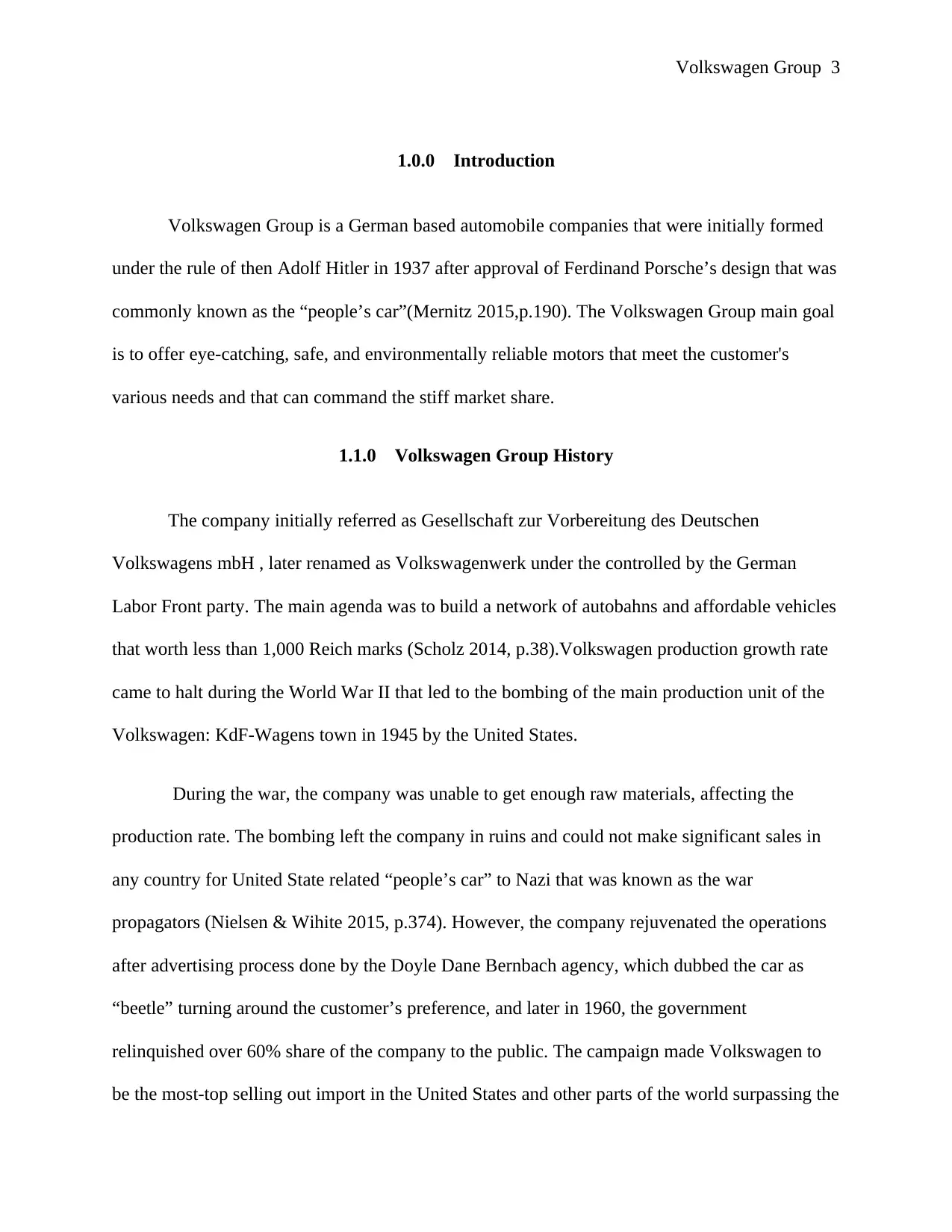
Volkswagen Group 3
1.0.0 Introduction
Volkswagen Group is a German based automobile companies that were initially formed
under the rule of then Adolf Hitler in 1937 after approval of Ferdinand Porsche’s design that was
commonly known as the “people’s car”(Mernitz 2015,p.190). The Volkswagen Group main goal
is to offer eye-catching, safe, and environmentally reliable motors that meet the customer's
various needs and that can command the stiff market share.
1.1.0 Volkswagen Group History
The company initially referred as Gesellschaft zur Vorbereitung des Deutschen
Volkswagens mbH , later renamed as Volkswagenwerk under the controlled by the German
Labor Front party. The main agenda was to build a network of autobahns and affordable vehicles
that worth less than 1,000 Reich marks (Scholz 2014, p.38).Volkswagen production growth rate
came to halt during the World War II that led to the bombing of the main production unit of the
Volkswagen: KdF-Wagens town in 1945 by the United States.
During the war, the company was unable to get enough raw materials, affecting the
production rate. The bombing left the company in ruins and could not make significant sales in
any country for United State related “people’s car” to Nazi that was known as the war
propagators (Nielsen & Wihite 2015, p.374). However, the company rejuvenated the operations
after advertising process done by the Doyle Dane Bernbach agency, which dubbed the car as
“beetle” turning around the customer’s preference, and later in 1960, the government
relinquished over 60% share of the company to the public. The campaign made Volkswagen to
be the most-top selling out import in the United States and other parts of the world surpassing the
1.0.0 Introduction
Volkswagen Group is a German based automobile companies that were initially formed
under the rule of then Adolf Hitler in 1937 after approval of Ferdinand Porsche’s design that was
commonly known as the “people’s car”(Mernitz 2015,p.190). The Volkswagen Group main goal
is to offer eye-catching, safe, and environmentally reliable motors that meet the customer's
various needs and that can command the stiff market share.
1.1.0 Volkswagen Group History
The company initially referred as Gesellschaft zur Vorbereitung des Deutschen
Volkswagens mbH , later renamed as Volkswagenwerk under the controlled by the German
Labor Front party. The main agenda was to build a network of autobahns and affordable vehicles
that worth less than 1,000 Reich marks (Scholz 2014, p.38).Volkswagen production growth rate
came to halt during the World War II that led to the bombing of the main production unit of the
Volkswagen: KdF-Wagens town in 1945 by the United States.
During the war, the company was unable to get enough raw materials, affecting the
production rate. The bombing left the company in ruins and could not make significant sales in
any country for United State related “people’s car” to Nazi that was known as the war
propagators (Nielsen & Wihite 2015, p.374). However, the company rejuvenated the operations
after advertising process done by the Doyle Dane Bernbach agency, which dubbed the car as
“beetle” turning around the customer’s preference, and later in 1960, the government
relinquished over 60% share of the company to the public. The campaign made Volkswagen to
be the most-top selling out import in the United States and other parts of the world surpassing the
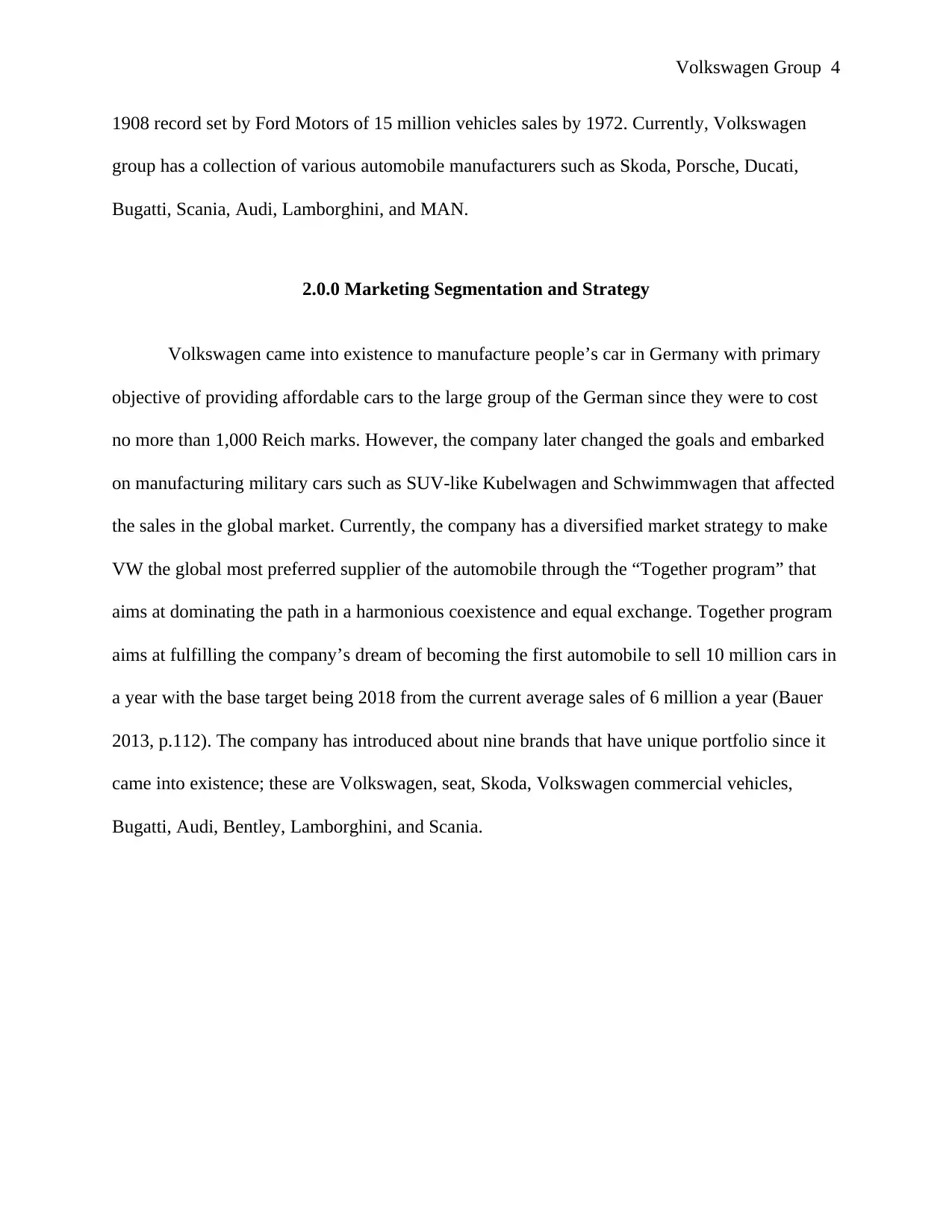
Volkswagen Group 4
1908 record set by Ford Motors of 15 million vehicles sales by 1972. Currently, Volkswagen
group has a collection of various automobile manufacturers such as Skoda, Porsche, Ducati,
Bugatti, Scania, Audi, Lamborghini, and MAN.
2.0.0 Marketing Segmentation and Strategy
Volkswagen came into existence to manufacture people’s car in Germany with primary
objective of providing affordable cars to the large group of the German since they were to cost
no more than 1,000 Reich marks. However, the company later changed the goals and embarked
on manufacturing military cars such as SUV-like Kubelwagen and Schwimmwagen that affected
the sales in the global market. Currently, the company has a diversified market strategy to make
VW the global most preferred supplier of the automobile through the “Together program” that
aims at dominating the path in a harmonious coexistence and equal exchange. Together program
aims at fulfilling the company’s dream of becoming the first automobile to sell 10 million cars in
a year with the base target being 2018 from the current average sales of 6 million a year (Bauer
2013, p.112). The company has introduced about nine brands that have unique portfolio since it
came into existence; these are Volkswagen, seat, Skoda, Volkswagen commercial vehicles,
Bugatti, Audi, Bentley, Lamborghini, and Scania.
1908 record set by Ford Motors of 15 million vehicles sales by 1972. Currently, Volkswagen
group has a collection of various automobile manufacturers such as Skoda, Porsche, Ducati,
Bugatti, Scania, Audi, Lamborghini, and MAN.
2.0.0 Marketing Segmentation and Strategy
Volkswagen came into existence to manufacture people’s car in Germany with primary
objective of providing affordable cars to the large group of the German since they were to cost
no more than 1,000 Reich marks. However, the company later changed the goals and embarked
on manufacturing military cars such as SUV-like Kubelwagen and Schwimmwagen that affected
the sales in the global market. Currently, the company has a diversified market strategy to make
VW the global most preferred supplier of the automobile through the “Together program” that
aims at dominating the path in a harmonious coexistence and equal exchange. Together program
aims at fulfilling the company’s dream of becoming the first automobile to sell 10 million cars in
a year with the base target being 2018 from the current average sales of 6 million a year (Bauer
2013, p.112). The company has introduced about nine brands that have unique portfolio since it
came into existence; these are Volkswagen, seat, Skoda, Volkswagen commercial vehicles,
Bugatti, Audi, Bentley, Lamborghini, and Scania.
Secure Best Marks with AI Grader
Need help grading? Try our AI Grader for instant feedback on your assignments.
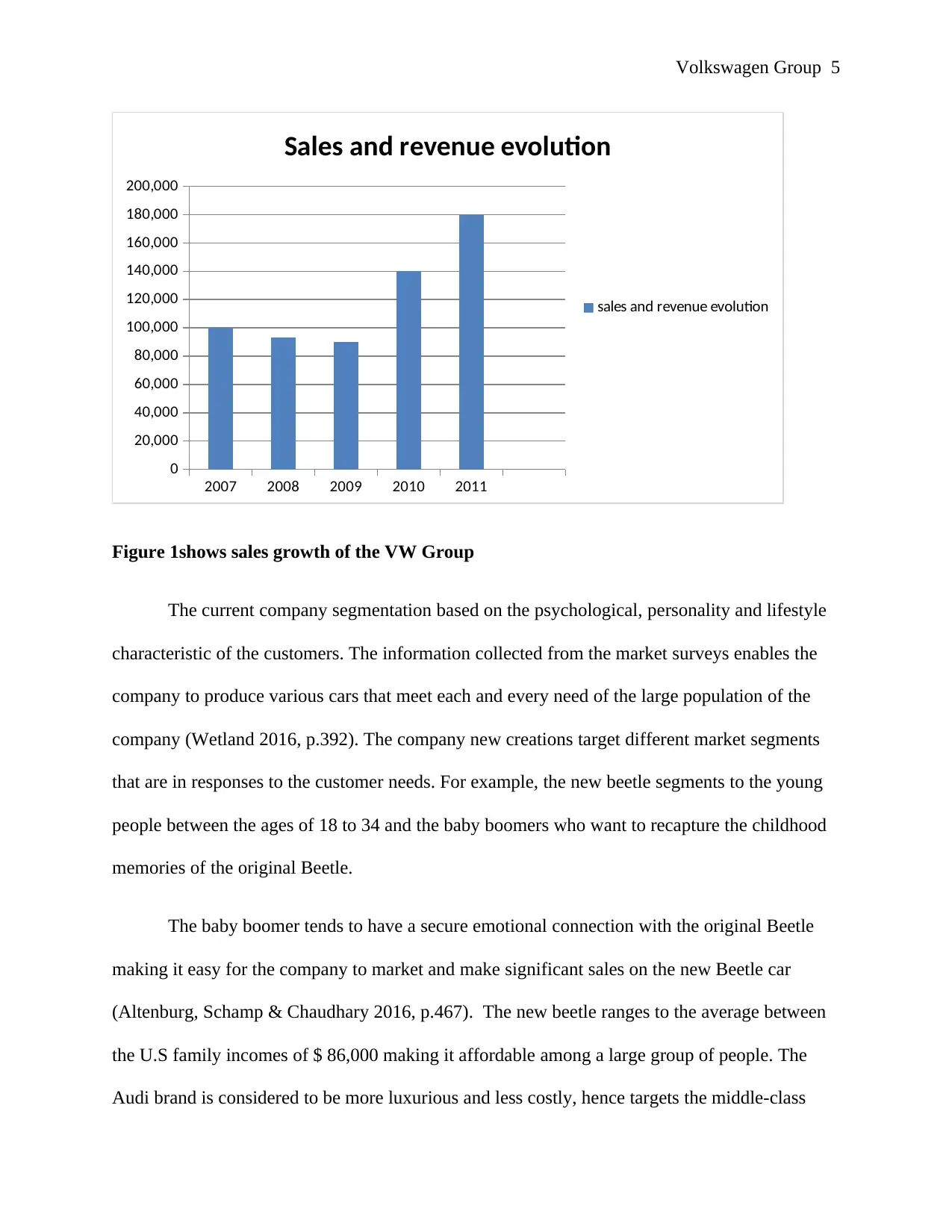
Volkswagen Group 5
2007 2008 2009 2010 2011
0
20,000
40,000
60,000
80,000
100,000
120,000
140,000
160,000
180,000
200,000
Sales and revenue evolution
sales and revenue evolution
Figure 1shows sales growth of the VW Group
The current company segmentation based on the psychological, personality and lifestyle
characteristic of the customers. The information collected from the market surveys enables the
company to produce various cars that meet each and every need of the large population of the
company (Wetland 2016, p.392). The company new creations target different market segments
that are in responses to the customer needs. For example, the new beetle segments to the young
people between the ages of 18 to 34 and the baby boomers who want to recapture the childhood
memories of the original Beetle.
The baby boomer tends to have a secure emotional connection with the original Beetle
making it easy for the company to market and make significant sales on the new Beetle car
(Altenburg, Schamp & Chaudhary 2016, p.467). The new beetle ranges to the average between
the U.S family incomes of $ 86,000 making it affordable among a large group of people. The
Audi brand is considered to be more luxurious and less costly, hence targets the middle-class
2007 2008 2009 2010 2011
0
20,000
40,000
60,000
80,000
100,000
120,000
140,000
160,000
180,000
200,000
Sales and revenue evolution
sales and revenue evolution
Figure 1shows sales growth of the VW Group
The current company segmentation based on the psychological, personality and lifestyle
characteristic of the customers. The information collected from the market surveys enables the
company to produce various cars that meet each and every need of the large population of the
company (Wetland 2016, p.392). The company new creations target different market segments
that are in responses to the customer needs. For example, the new beetle segments to the young
people between the ages of 18 to 34 and the baby boomers who want to recapture the childhood
memories of the original Beetle.
The baby boomer tends to have a secure emotional connection with the original Beetle
making it easy for the company to market and make significant sales on the new Beetle car
(Altenburg, Schamp & Chaudhary 2016, p.467). The new beetle ranges to the average between
the U.S family incomes of $ 86,000 making it affordable among a large group of people. The
Audi brand is considered to be more luxurious and less costly, hence targets the middle-class
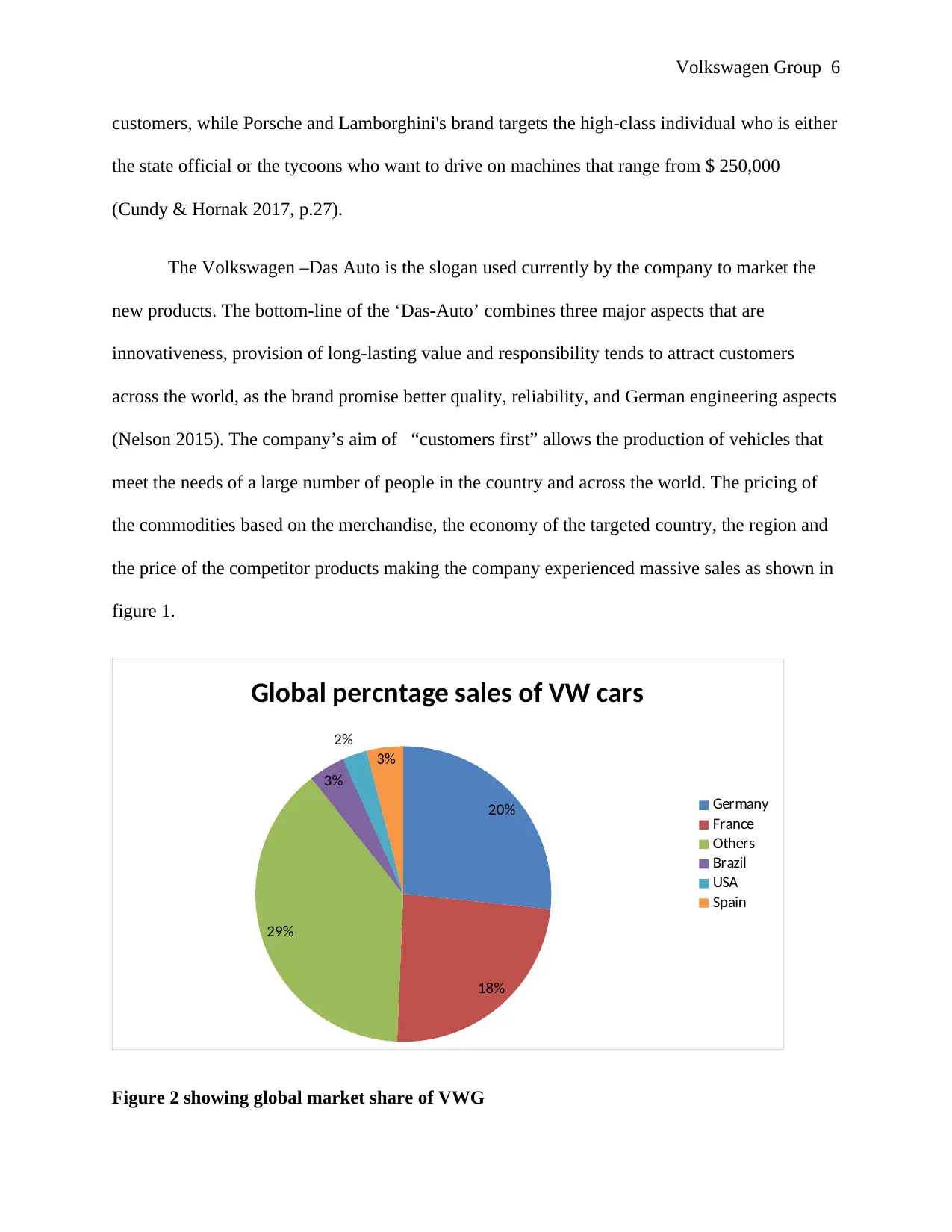
Volkswagen Group 6
customers, while Porsche and Lamborghini's brand targets the high-class individual who is either
the state official or the tycoons who want to drive on machines that range from $ 250,000
(Cundy & Hornak 2017, p.27).
The Volkswagen –Das Auto is the slogan used currently by the company to market the
new products. The bottom-line of the ‘Das-Auto’ combines three major aspects that are
innovativeness, provision of long-lasting value and responsibility tends to attract customers
across the world, as the brand promise better quality, reliability, and German engineering aspects
(Nelson 2015). The company’s aim of “customers first” allows the production of vehicles that
meet the needs of a large number of people in the country and across the world. The pricing of
the commodities based on the merchandise, the economy of the targeted country, the region and
the price of the competitor products making the company experienced massive sales as shown in
figure 1.
20%
18%
29%
3%
2%
3%
Global percntage sales of VW cars
Germany
France
Others
Brazil
USA
Spain
Figure 2 showing global market share of VWG
customers, while Porsche and Lamborghini's brand targets the high-class individual who is either
the state official or the tycoons who want to drive on machines that range from $ 250,000
(Cundy & Hornak 2017, p.27).
The Volkswagen –Das Auto is the slogan used currently by the company to market the
new products. The bottom-line of the ‘Das-Auto’ combines three major aspects that are
innovativeness, provision of long-lasting value and responsibility tends to attract customers
across the world, as the brand promise better quality, reliability, and German engineering aspects
(Nelson 2015). The company’s aim of “customers first” allows the production of vehicles that
meet the needs of a large number of people in the country and across the world. The pricing of
the commodities based on the merchandise, the economy of the targeted country, the region and
the price of the competitor products making the company experienced massive sales as shown in
figure 1.
20%
18%
29%
3%
2%
3%
Global percntage sales of VW cars
Germany
France
Others
Brazil
USA
Spain
Figure 2 showing global market share of VWG
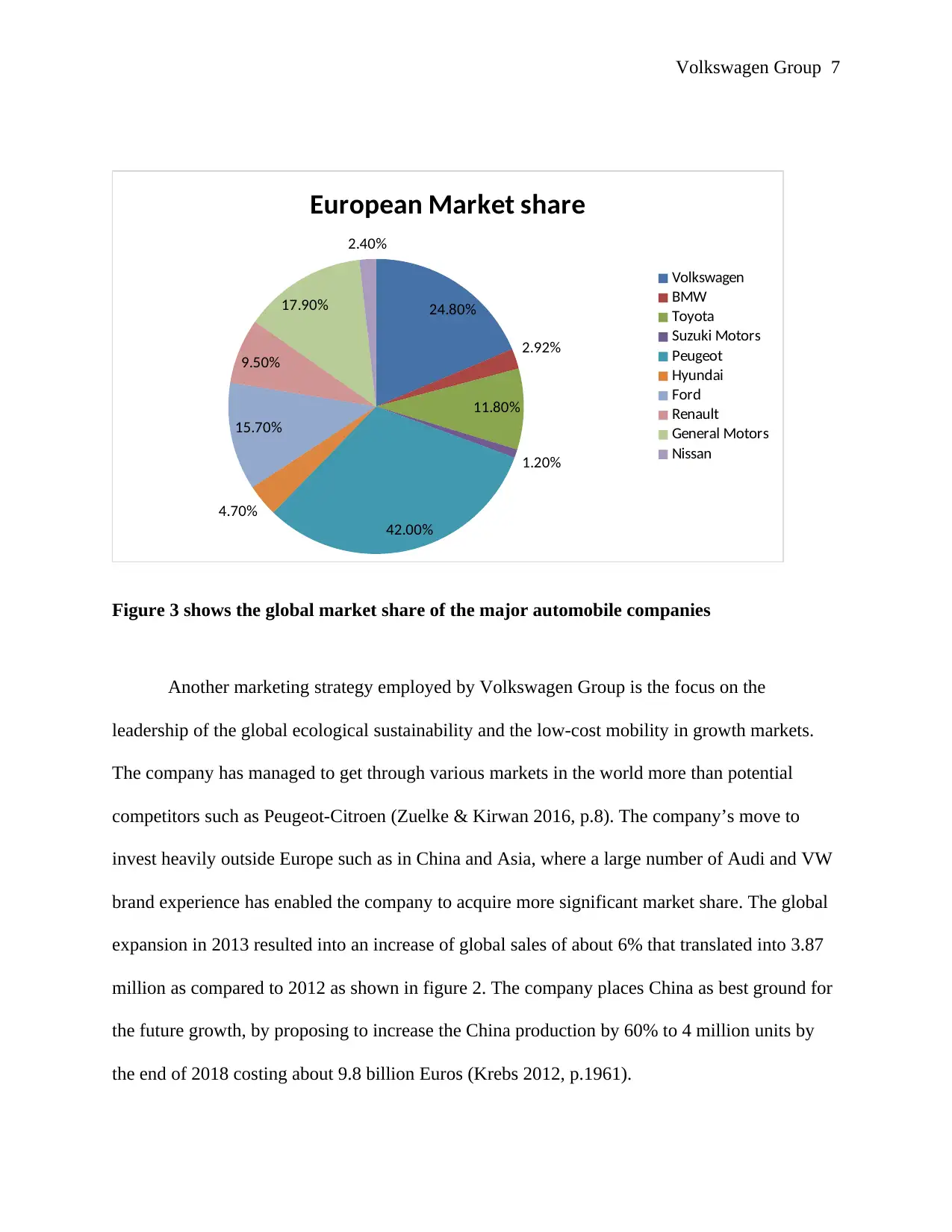
Volkswagen Group 7
24.80%
2.92%
11.80%
1.20%
42.00%
4.70%
15.70%
9.50%
17.90%
2.40%
European Market share
Volkswagen
BMW
Toyota
Suzuki Motors
Peugeot
Hyundai
Ford
Renault
General Motors
Nissan
Figure 3 shows the global market share of the major automobile companies
Another marketing strategy employed by Volkswagen Group is the focus on the
leadership of the global ecological sustainability and the low-cost mobility in growth markets.
The company has managed to get through various markets in the world more than potential
competitors such as Peugeot-Citroen (Zuelke & Kirwan 2016, p.8). The company’s move to
invest heavily outside Europe such as in China and Asia, where a large number of Audi and VW
brand experience has enabled the company to acquire more significant market share. The global
expansion in 2013 resulted into an increase of global sales of about 6% that translated into 3.87
million as compared to 2012 as shown in figure 2. The company places China as best ground for
the future growth, by proposing to increase the China production by 60% to 4 million units by
the end of 2018 costing about 9.8 billion Euros (Krebs 2012, p.1961).
24.80%
2.92%
11.80%
1.20%
42.00%
4.70%
15.70%
9.50%
17.90%
2.40%
European Market share
Volkswagen
BMW
Toyota
Suzuki Motors
Peugeot
Hyundai
Ford
Renault
General Motors
Nissan
Figure 3 shows the global market share of the major automobile companies
Another marketing strategy employed by Volkswagen Group is the focus on the
leadership of the global ecological sustainability and the low-cost mobility in growth markets.
The company has managed to get through various markets in the world more than potential
competitors such as Peugeot-Citroen (Zuelke & Kirwan 2016, p.8). The company’s move to
invest heavily outside Europe such as in China and Asia, where a large number of Audi and VW
brand experience has enabled the company to acquire more significant market share. The global
expansion in 2013 resulted into an increase of global sales of about 6% that translated into 3.87
million as compared to 2012 as shown in figure 2. The company places China as best ground for
the future growth, by proposing to increase the China production by 60% to 4 million units by
the end of 2018 costing about 9.8 billion Euros (Krebs 2012, p.1961).
Paraphrase This Document
Need a fresh take? Get an instant paraphrase of this document with our AI Paraphraser
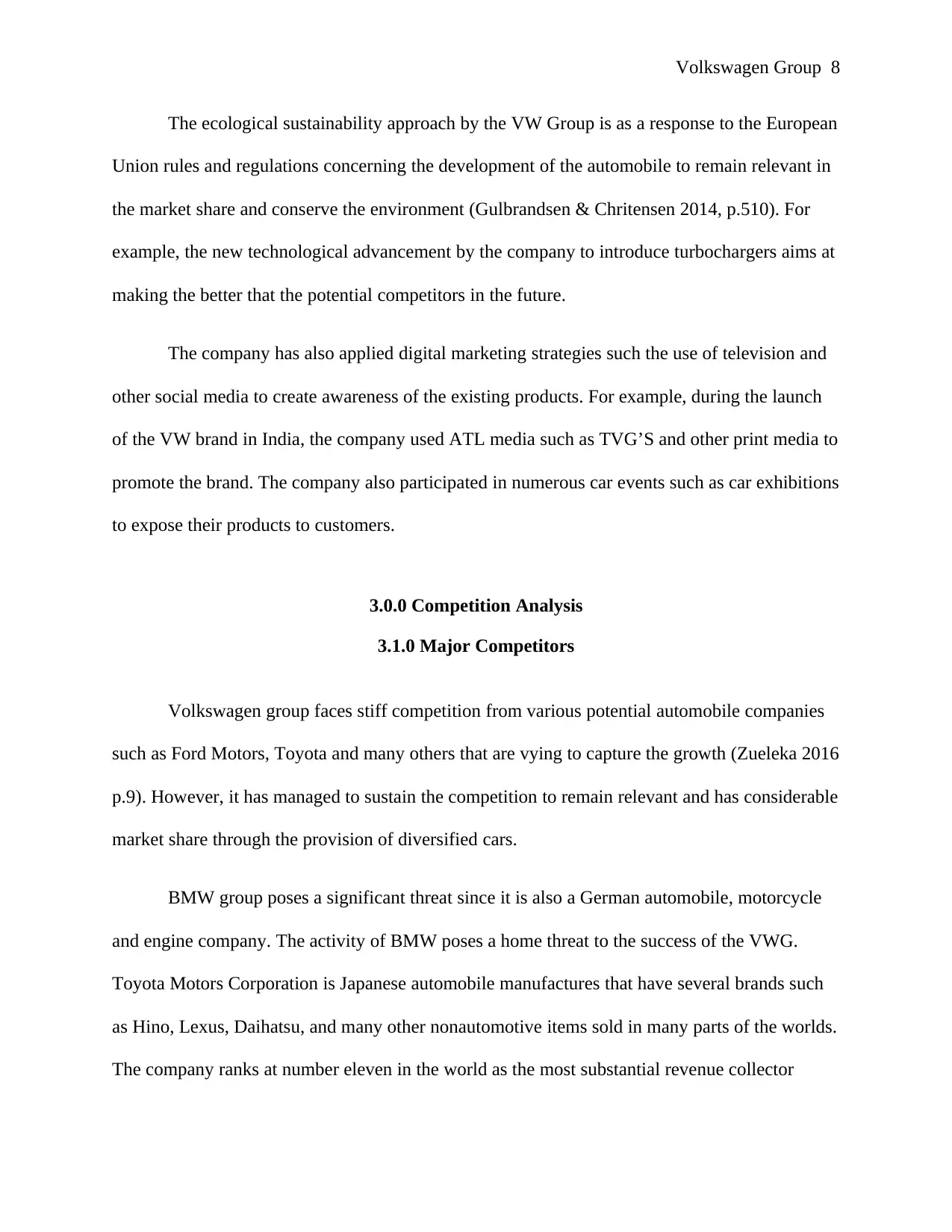
Volkswagen Group 8
The ecological sustainability approach by the VW Group is as a response to the European
Union rules and regulations concerning the development of the automobile to remain relevant in
the market share and conserve the environment (Gulbrandsen & Chritensen 2014, p.510). For
example, the new technological advancement by the company to introduce turbochargers aims at
making the better that the potential competitors in the future.
The company has also applied digital marketing strategies such the use of television and
other social media to create awareness of the existing products. For example, during the launch
of the VW brand in India, the company used ATL media such as TVG’S and other print media to
promote the brand. The company also participated in numerous car events such as car exhibitions
to expose their products to customers.
3.0.0 Competition Analysis
3.1.0 Major Competitors
Volkswagen group faces stiff competition from various potential automobile companies
such as Ford Motors, Toyota and many others that are vying to capture the growth (Zueleka 2016
p.9). However, it has managed to sustain the competition to remain relevant and has considerable
market share through the provision of diversified cars.
BMW group poses a significant threat since it is also a German automobile, motorcycle
and engine company. The activity of BMW poses a home threat to the success of the VWG.
Toyota Motors Corporation is Japanese automobile manufactures that have several brands such
as Hino, Lexus, Daihatsu, and many other nonautomotive items sold in many parts of the worlds.
The company ranks at number eleven in the world as the most substantial revenue collector
The ecological sustainability approach by the VW Group is as a response to the European
Union rules and regulations concerning the development of the automobile to remain relevant in
the market share and conserve the environment (Gulbrandsen & Chritensen 2014, p.510). For
example, the new technological advancement by the company to introduce turbochargers aims at
making the better that the potential competitors in the future.
The company has also applied digital marketing strategies such the use of television and
other social media to create awareness of the existing products. For example, during the launch
of the VW brand in India, the company used ATL media such as TVG’S and other print media to
promote the brand. The company also participated in numerous car events such as car exhibitions
to expose their products to customers.
3.0.0 Competition Analysis
3.1.0 Major Competitors
Volkswagen group faces stiff competition from various potential automobile companies
such as Ford Motors, Toyota and many others that are vying to capture the growth (Zueleka 2016
p.9). However, it has managed to sustain the competition to remain relevant and has considerable
market share through the provision of diversified cars.
BMW group poses a significant threat since it is also a German automobile, motorcycle
and engine company. The activity of BMW poses a home threat to the success of the VWG.
Toyota Motors Corporation is Japanese automobile manufactures that have several brands such
as Hino, Lexus, Daihatsu, and many other nonautomotive items sold in many parts of the worlds.
The company ranks at number eleven in the world as the most substantial revenue collector
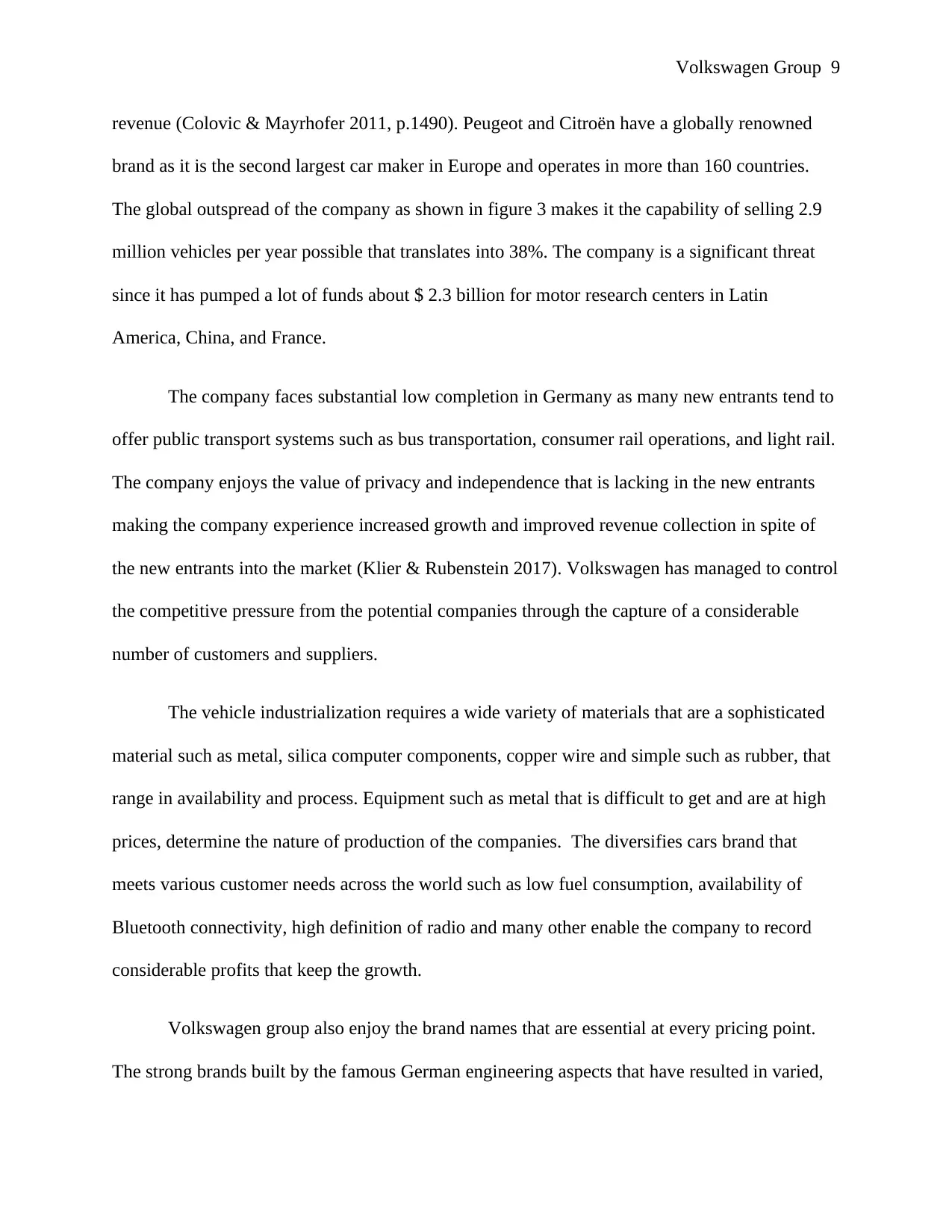
Volkswagen Group 9
revenue (Colovic & Mayrhofer 2011, p.1490). Peugeot and Citroën have a globally renowned
brand as it is the second largest car maker in Europe and operates in more than 160 countries.
The global outspread of the company as shown in figure 3 makes it the capability of selling 2.9
million vehicles per year possible that translates into 38%. The company is a significant threat
since it has pumped a lot of funds about $ 2.3 billion for motor research centers in Latin
America, China, and France.
The company faces substantial low completion in Germany as many new entrants tend to
offer public transport systems such as bus transportation, consumer rail operations, and light rail.
The company enjoys the value of privacy and independence that is lacking in the new entrants
making the company experience increased growth and improved revenue collection in spite of
the new entrants into the market (Klier & Rubenstein 2017). Volkswagen has managed to control
the competitive pressure from the potential companies through the capture of a considerable
number of customers and suppliers.
The vehicle industrialization requires a wide variety of materials that are a sophisticated
material such as metal, silica computer components, copper wire and simple such as rubber, that
range in availability and process. Equipment such as metal that is difficult to get and are at high
prices, determine the nature of production of the companies. The diversifies cars brand that
meets various customer needs across the world such as low fuel consumption, availability of
Bluetooth connectivity, high definition of radio and many other enable the company to record
considerable profits that keep the growth.
Volkswagen group also enjoy the brand names that are essential at every pricing point.
The strong brands built by the famous German engineering aspects that have resulted in varied,
revenue (Colovic & Mayrhofer 2011, p.1490). Peugeot and Citroën have a globally renowned
brand as it is the second largest car maker in Europe and operates in more than 160 countries.
The global outspread of the company as shown in figure 3 makes it the capability of selling 2.9
million vehicles per year possible that translates into 38%. The company is a significant threat
since it has pumped a lot of funds about $ 2.3 billion for motor research centers in Latin
America, China, and France.
The company faces substantial low completion in Germany as many new entrants tend to
offer public transport systems such as bus transportation, consumer rail operations, and light rail.
The company enjoys the value of privacy and independence that is lacking in the new entrants
making the company experience increased growth and improved revenue collection in spite of
the new entrants into the market (Klier & Rubenstein 2017). Volkswagen has managed to control
the competitive pressure from the potential companies through the capture of a considerable
number of customers and suppliers.
The vehicle industrialization requires a wide variety of materials that are a sophisticated
material such as metal, silica computer components, copper wire and simple such as rubber, that
range in availability and process. Equipment such as metal that is difficult to get and are at high
prices, determine the nature of production of the companies. The diversifies cars brand that
meets various customer needs across the world such as low fuel consumption, availability of
Bluetooth connectivity, high definition of radio and many other enable the company to record
considerable profits that keep the growth.
Volkswagen group also enjoy the brand names that are essential at every pricing point.
The strong brands built by the famous German engineering aspects that have resulted in varied,
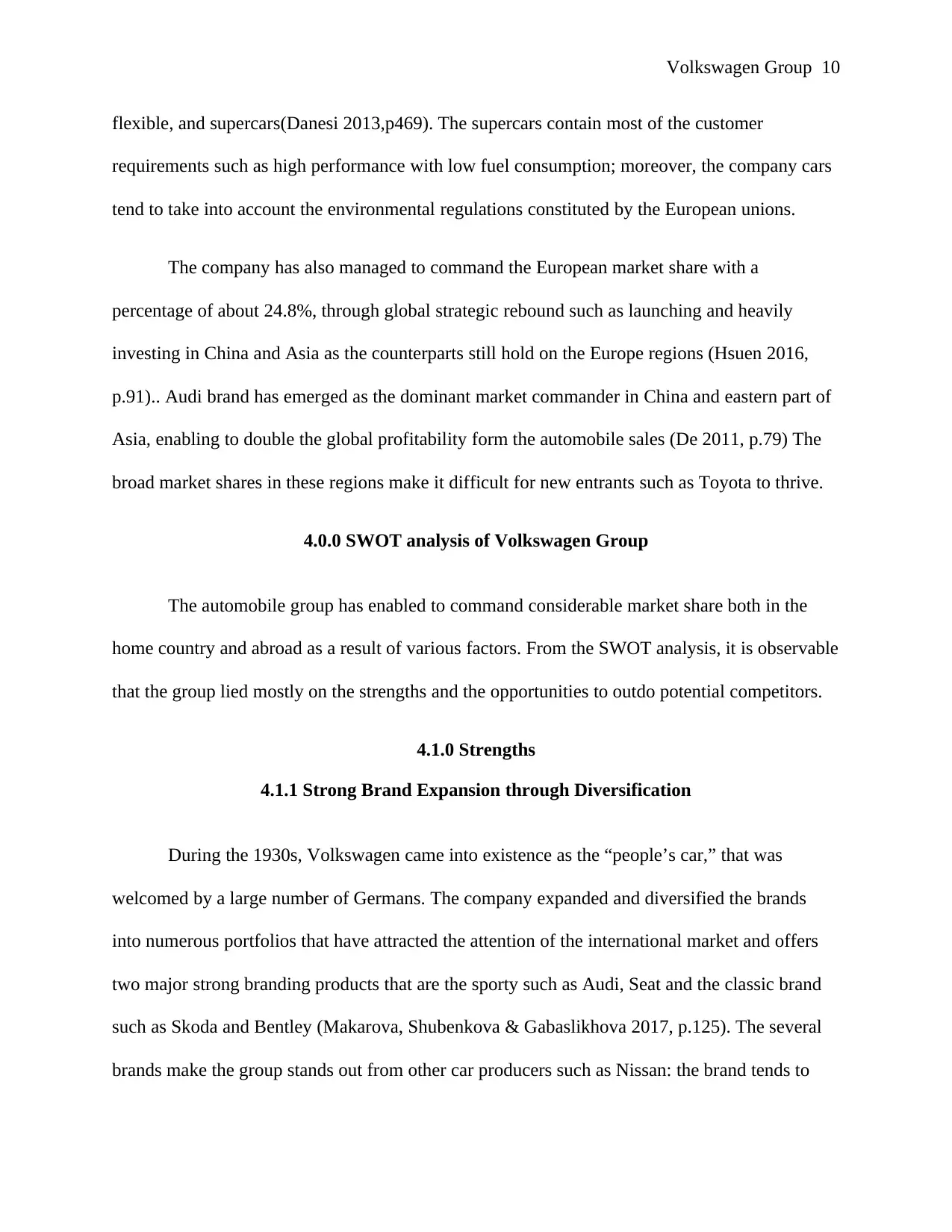
Volkswagen Group 10
flexible, and supercars(Danesi 2013,p469). The supercars contain most of the customer
requirements such as high performance with low fuel consumption; moreover, the company cars
tend to take into account the environmental regulations constituted by the European unions.
The company has also managed to command the European market share with a
percentage of about 24.8%, through global strategic rebound such as launching and heavily
investing in China and Asia as the counterparts still hold on the Europe regions (Hsuen 2016,
p.91).. Audi brand has emerged as the dominant market commander in China and eastern part of
Asia, enabling to double the global profitability form the automobile sales (De 2011, p.79) The
broad market shares in these regions make it difficult for new entrants such as Toyota to thrive.
4.0.0 SWOT analysis of Volkswagen Group
The automobile group has enabled to command considerable market share both in the
home country and abroad as a result of various factors. From the SWOT analysis, it is observable
that the group lied mostly on the strengths and the opportunities to outdo potential competitors.
4.1.0 Strengths
4.1.1 Strong Brand Expansion through Diversification
During the 1930s, Volkswagen came into existence as the “people’s car,” that was
welcomed by a large number of Germans. The company expanded and diversified the brands
into numerous portfolios that have attracted the attention of the international market and offers
two major strong branding products that are the sporty such as Audi, Seat and the classic brand
such as Skoda and Bentley (Makarova, Shubenkova & Gabaslikhova 2017, p.125). The several
brands make the group stands out from other car producers such as Nissan: the brand tends to
flexible, and supercars(Danesi 2013,p469). The supercars contain most of the customer
requirements such as high performance with low fuel consumption; moreover, the company cars
tend to take into account the environmental regulations constituted by the European unions.
The company has also managed to command the European market share with a
percentage of about 24.8%, through global strategic rebound such as launching and heavily
investing in China and Asia as the counterparts still hold on the Europe regions (Hsuen 2016,
p.91).. Audi brand has emerged as the dominant market commander in China and eastern part of
Asia, enabling to double the global profitability form the automobile sales (De 2011, p.79) The
broad market shares in these regions make it difficult for new entrants such as Toyota to thrive.
4.0.0 SWOT analysis of Volkswagen Group
The automobile group has enabled to command considerable market share both in the
home country and abroad as a result of various factors. From the SWOT analysis, it is observable
that the group lied mostly on the strengths and the opportunities to outdo potential competitors.
4.1.0 Strengths
4.1.1 Strong Brand Expansion through Diversification
During the 1930s, Volkswagen came into existence as the “people’s car,” that was
welcomed by a large number of Germans. The company expanded and diversified the brands
into numerous portfolios that have attracted the attention of the international market and offers
two major strong branding products that are the sporty such as Audi, Seat and the classic brand
such as Skoda and Bentley (Makarova, Shubenkova & Gabaslikhova 2017, p.125). The several
brands make the group stands out from other car producers such as Nissan: the brand tends to
Secure Best Marks with AI Grader
Need help grading? Try our AI Grader for instant feedback on your assignments.
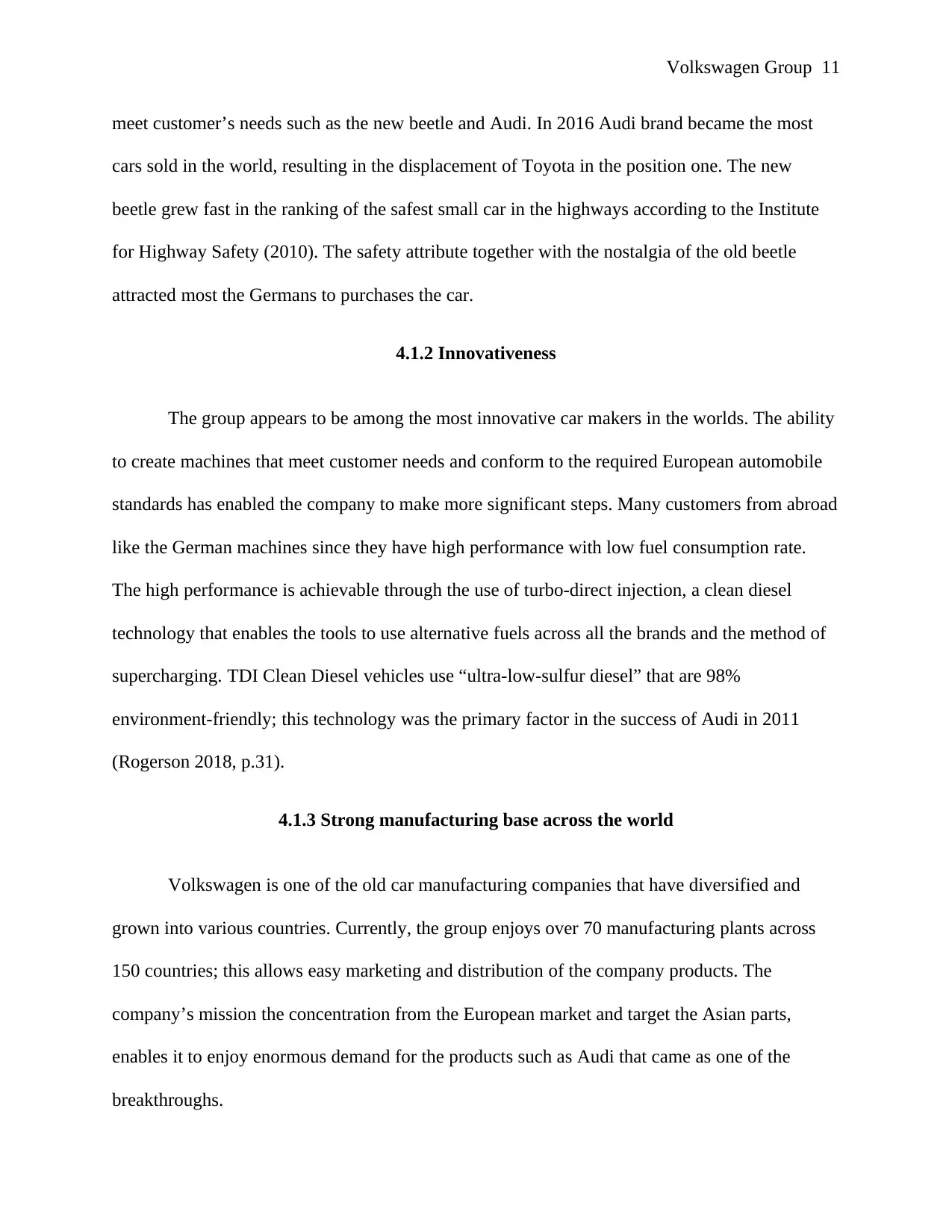
Volkswagen Group 11
meet customer’s needs such as the new beetle and Audi. In 2016 Audi brand became the most
cars sold in the world, resulting in the displacement of Toyota in the position one. The new
beetle grew fast in the ranking of the safest small car in the highways according to the Institute
for Highway Safety (2010). The safety attribute together with the nostalgia of the old beetle
attracted most the Germans to purchases the car.
4.1.2 Innovativeness
The group appears to be among the most innovative car makers in the worlds. The ability
to create machines that meet customer needs and conform to the required European automobile
standards has enabled the company to make more significant steps. Many customers from abroad
like the German machines since they have high performance with low fuel consumption rate.
The high performance is achievable through the use of turbo-direct injection, a clean diesel
technology that enables the tools to use alternative fuels across all the brands and the method of
supercharging. TDI Clean Diesel vehicles use “ultra-low-sulfur diesel” that are 98%
environment-friendly; this technology was the primary factor in the success of Audi in 2011
(Rogerson 2018, p.31).
4.1.3 Strong manufacturing base across the world
Volkswagen is one of the old car manufacturing companies that have diversified and
grown into various countries. Currently, the group enjoys over 70 manufacturing plants across
150 countries; this allows easy marketing and distribution of the company products. The
company’s mission the concentration from the European market and target the Asian parts,
enables it to enjoy enormous demand for the products such as Audi that came as one of the
breakthroughs.
meet customer’s needs such as the new beetle and Audi. In 2016 Audi brand became the most
cars sold in the world, resulting in the displacement of Toyota in the position one. The new
beetle grew fast in the ranking of the safest small car in the highways according to the Institute
for Highway Safety (2010). The safety attribute together with the nostalgia of the old beetle
attracted most the Germans to purchases the car.
4.1.2 Innovativeness
The group appears to be among the most innovative car makers in the worlds. The ability
to create machines that meet customer needs and conform to the required European automobile
standards has enabled the company to make more significant steps. Many customers from abroad
like the German machines since they have high performance with low fuel consumption rate.
The high performance is achievable through the use of turbo-direct injection, a clean diesel
technology that enables the tools to use alternative fuels across all the brands and the method of
supercharging. TDI Clean Diesel vehicles use “ultra-low-sulfur diesel” that are 98%
environment-friendly; this technology was the primary factor in the success of Audi in 2011
(Rogerson 2018, p.31).
4.1.3 Strong manufacturing base across the world
Volkswagen is one of the old car manufacturing companies that have diversified and
grown into various countries. Currently, the group enjoys over 70 manufacturing plants across
150 countries; this allows easy marketing and distribution of the company products. The
company’s mission the concentration from the European market and target the Asian parts,
enables it to enjoy enormous demand for the products such as Audi that came as one of the
breakthroughs.
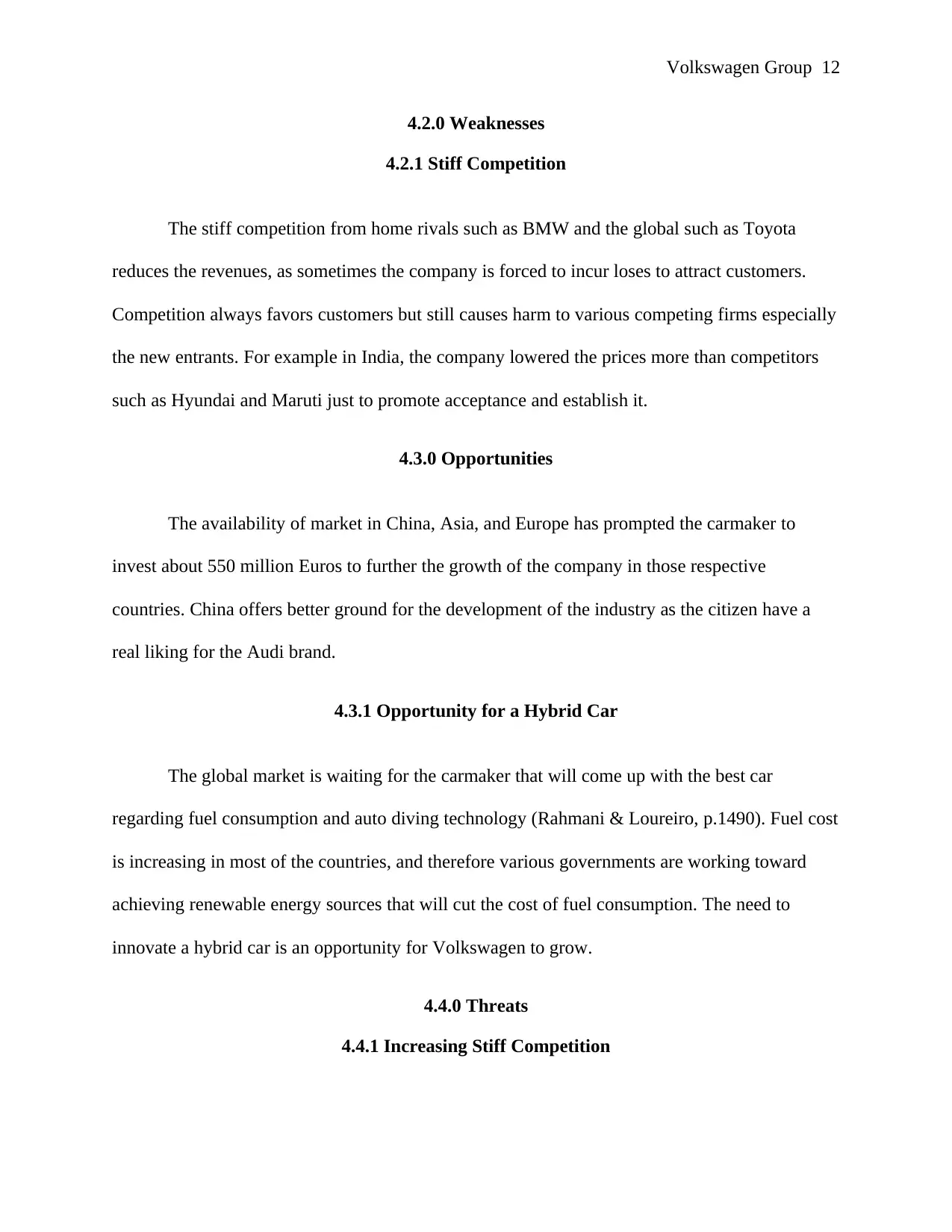
Volkswagen Group 12
4.2.0 Weaknesses
4.2.1 Stiff Competition
The stiff competition from home rivals such as BMW and the global such as Toyota
reduces the revenues, as sometimes the company is forced to incur loses to attract customers.
Competition always favors customers but still causes harm to various competing firms especially
the new entrants. For example in India, the company lowered the prices more than competitors
such as Hyundai and Maruti just to promote acceptance and establish it.
4.3.0 Opportunities
The availability of market in China, Asia, and Europe has prompted the carmaker to
invest about 550 million Euros to further the growth of the company in those respective
countries. China offers better ground for the development of the industry as the citizen have a
real liking for the Audi brand.
4.3.1 Opportunity for a Hybrid Car
The global market is waiting for the carmaker that will come up with the best car
regarding fuel consumption and auto diving technology (Rahmani & Loureiro, p.1490). Fuel cost
is increasing in most of the countries, and therefore various governments are working toward
achieving renewable energy sources that will cut the cost of fuel consumption. The need to
innovate a hybrid car is an opportunity for Volkswagen to grow.
4.4.0 Threats
4.4.1 Increasing Stiff Competition
4.2.0 Weaknesses
4.2.1 Stiff Competition
The stiff competition from home rivals such as BMW and the global such as Toyota
reduces the revenues, as sometimes the company is forced to incur loses to attract customers.
Competition always favors customers but still causes harm to various competing firms especially
the new entrants. For example in India, the company lowered the prices more than competitors
such as Hyundai and Maruti just to promote acceptance and establish it.
4.3.0 Opportunities
The availability of market in China, Asia, and Europe has prompted the carmaker to
invest about 550 million Euros to further the growth of the company in those respective
countries. China offers better ground for the development of the industry as the citizen have a
real liking for the Audi brand.
4.3.1 Opportunity for a Hybrid Car
The global market is waiting for the carmaker that will come up with the best car
regarding fuel consumption and auto diving technology (Rahmani & Loureiro, p.1490). Fuel cost
is increasing in most of the countries, and therefore various governments are working toward
achieving renewable energy sources that will cut the cost of fuel consumption. The need to
innovate a hybrid car is an opportunity for Volkswagen to grow.
4.4.0 Threats
4.4.1 Increasing Stiff Competition
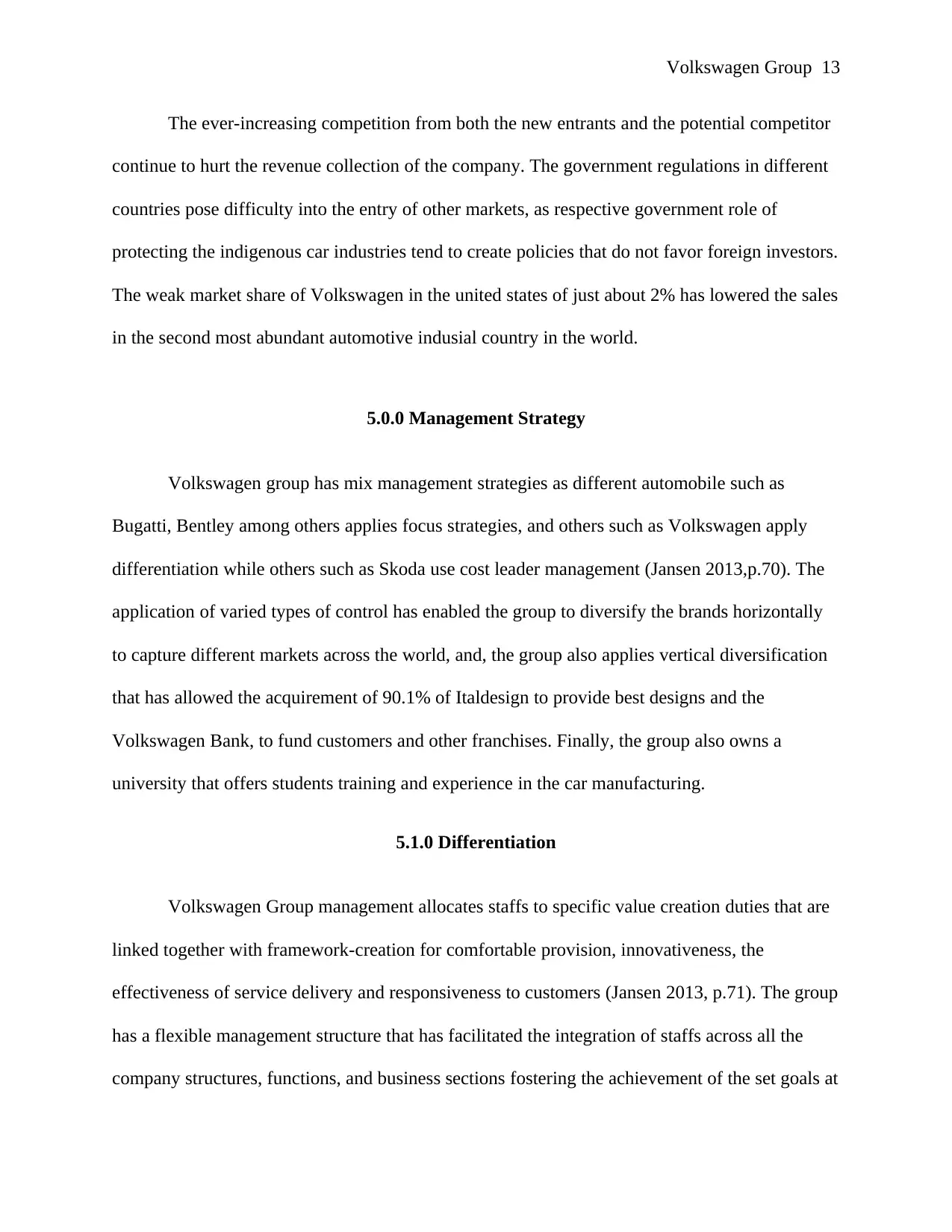
Volkswagen Group 13
The ever-increasing competition from both the new entrants and the potential competitor
continue to hurt the revenue collection of the company. The government regulations in different
countries pose difficulty into the entry of other markets, as respective government role of
protecting the indigenous car industries tend to create policies that do not favor foreign investors.
The weak market share of Volkswagen in the united states of just about 2% has lowered the sales
in the second most abundant automotive indusial country in the world.
5.0.0 Management Strategy
Volkswagen group has mix management strategies as different automobile such as
Bugatti, Bentley among others applies focus strategies, and others such as Volkswagen apply
differentiation while others such as Skoda use cost leader management (Jansen 2013,p.70). The
application of varied types of control has enabled the group to diversify the brands horizontally
to capture different markets across the world, and, the group also applies vertical diversification
that has allowed the acquirement of 90.1% of Italdesign to provide best designs and the
Volkswagen Bank, to fund customers and other franchises. Finally, the group also owns a
university that offers students training and experience in the car manufacturing.
5.1.0 Differentiation
Volkswagen Group management allocates staffs to specific value creation duties that are
linked together with framework-creation for comfortable provision, innovativeness, the
effectiveness of service delivery and responsiveness to customers (Jansen 2013, p.71). The group
has a flexible management structure that has facilitated the integration of staffs across all the
company structures, functions, and business sections fostering the achievement of the set goals at
The ever-increasing competition from both the new entrants and the potential competitor
continue to hurt the revenue collection of the company. The government regulations in different
countries pose difficulty into the entry of other markets, as respective government role of
protecting the indigenous car industries tend to create policies that do not favor foreign investors.
The weak market share of Volkswagen in the united states of just about 2% has lowered the sales
in the second most abundant automotive indusial country in the world.
5.0.0 Management Strategy
Volkswagen group has mix management strategies as different automobile such as
Bugatti, Bentley among others applies focus strategies, and others such as Volkswagen apply
differentiation while others such as Skoda use cost leader management (Jansen 2013,p.70). The
application of varied types of control has enabled the group to diversify the brands horizontally
to capture different markets across the world, and, the group also applies vertical diversification
that has allowed the acquirement of 90.1% of Italdesign to provide best designs and the
Volkswagen Bank, to fund customers and other franchises. Finally, the group also owns a
university that offers students training and experience in the car manufacturing.
5.1.0 Differentiation
Volkswagen Group management allocates staffs to specific value creation duties that are
linked together with framework-creation for comfortable provision, innovativeness, the
effectiveness of service delivery and responsiveness to customers (Jansen 2013, p.71). The group
has a flexible management structure that has facilitated the integration of staffs across all the
company structures, functions, and business sections fostering the achievement of the set goals at
Paraphrase This Document
Need a fresh take? Get an instant paraphrase of this document with our AI Paraphraser
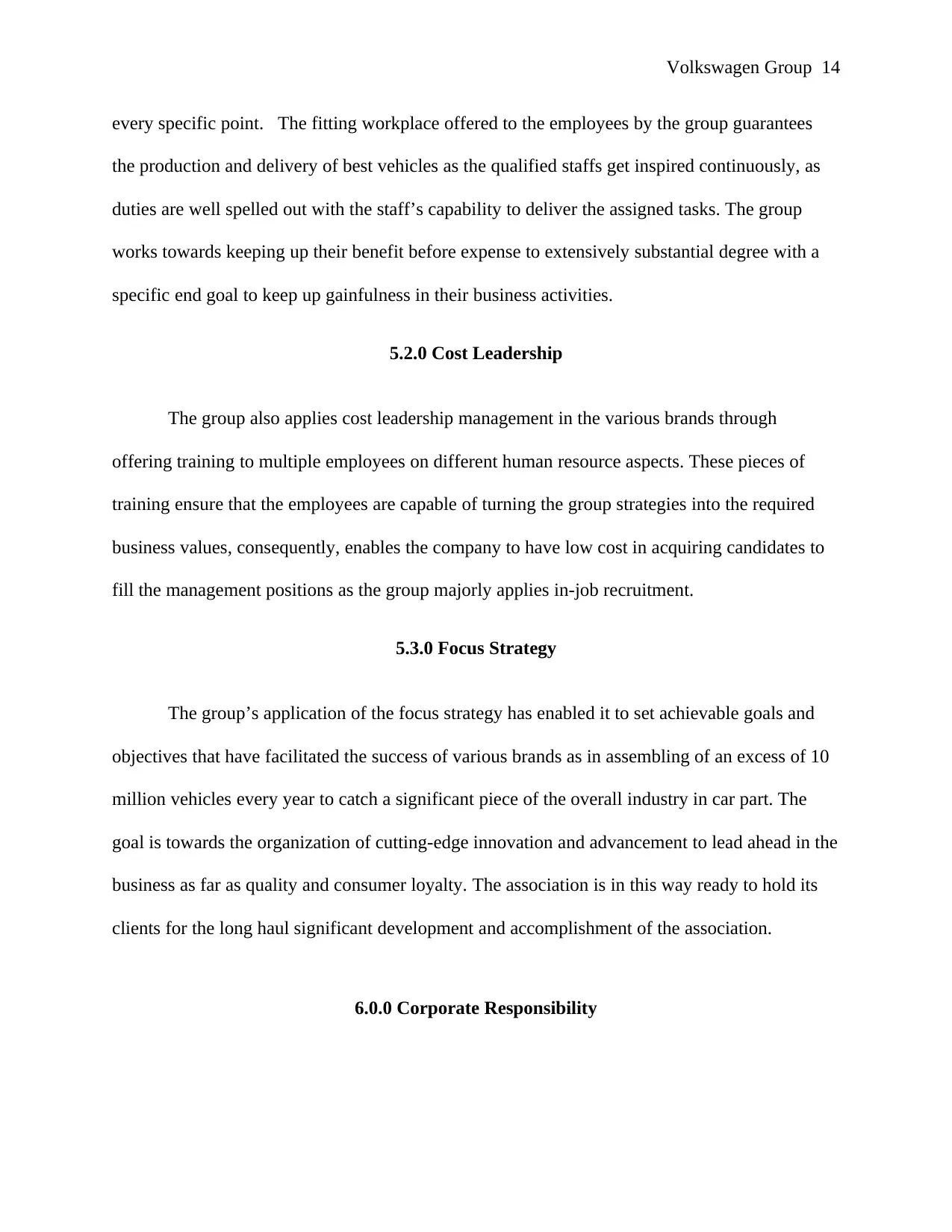
Volkswagen Group 14
every specific point. The fitting workplace offered to the employees by the group guarantees
the production and delivery of best vehicles as the qualified staffs get inspired continuously, as
duties are well spelled out with the staff’s capability to deliver the assigned tasks. The group
works towards keeping up their benefit before expense to extensively substantial degree with a
specific end goal to keep up gainfulness in their business activities.
5.2.0 Cost Leadership
The group also applies cost leadership management in the various brands through
offering training to multiple employees on different human resource aspects. These pieces of
training ensure that the employees are capable of turning the group strategies into the required
business values, consequently, enables the company to have low cost in acquiring candidates to
fill the management positions as the group majorly applies in-job recruitment.
5.3.0 Focus Strategy
The group’s application of the focus strategy has enabled it to set achievable goals and
objectives that have facilitated the success of various brands as in assembling of an excess of 10
million vehicles every year to catch a significant piece of the overall industry in car part. The
goal is towards the organization of cutting-edge innovation and advancement to lead ahead in the
business as far as quality and consumer loyalty. The association is in this way ready to hold its
clients for the long haul significant development and accomplishment of the association.
6.0.0 Corporate Responsibility
every specific point. The fitting workplace offered to the employees by the group guarantees
the production and delivery of best vehicles as the qualified staffs get inspired continuously, as
duties are well spelled out with the staff’s capability to deliver the assigned tasks. The group
works towards keeping up their benefit before expense to extensively substantial degree with a
specific end goal to keep up gainfulness in their business activities.
5.2.0 Cost Leadership
The group also applies cost leadership management in the various brands through
offering training to multiple employees on different human resource aspects. These pieces of
training ensure that the employees are capable of turning the group strategies into the required
business values, consequently, enables the company to have low cost in acquiring candidates to
fill the management positions as the group majorly applies in-job recruitment.
5.3.0 Focus Strategy
The group’s application of the focus strategy has enabled it to set achievable goals and
objectives that have facilitated the success of various brands as in assembling of an excess of 10
million vehicles every year to catch a significant piece of the overall industry in car part. The
goal is towards the organization of cutting-edge innovation and advancement to lead ahead in the
business as far as quality and consumer loyalty. The association is in this way ready to hold its
clients for the long haul significant development and accomplishment of the association.
6.0.0 Corporate Responsibility
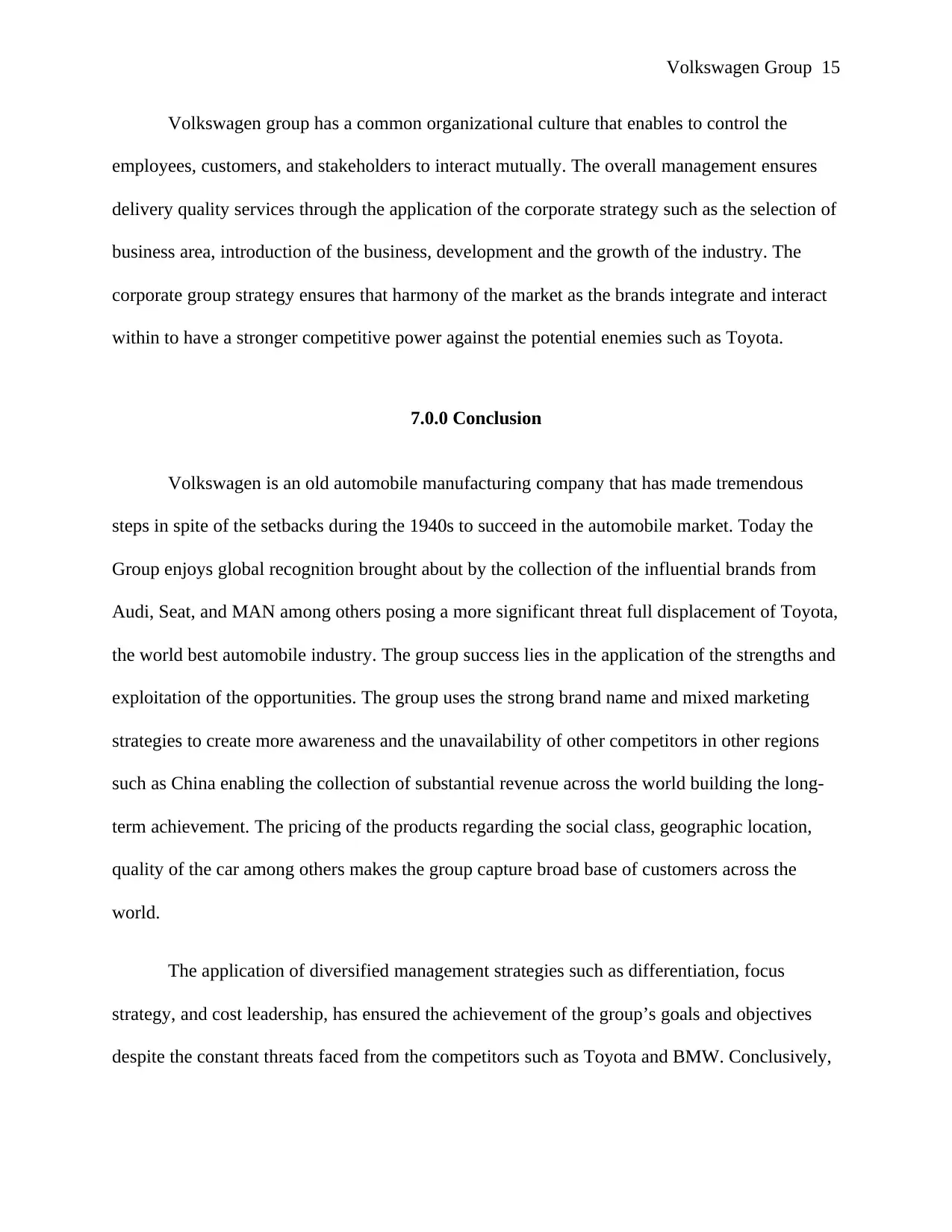
Volkswagen Group 15
Volkswagen group has a common organizational culture that enables to control the
employees, customers, and stakeholders to interact mutually. The overall management ensures
delivery quality services through the application of the corporate strategy such as the selection of
business area, introduction of the business, development and the growth of the industry. The
corporate group strategy ensures that harmony of the market as the brands integrate and interact
within to have a stronger competitive power against the potential enemies such as Toyota.
7.0.0 Conclusion
Volkswagen is an old automobile manufacturing company that has made tremendous
steps in spite of the setbacks during the 1940s to succeed in the automobile market. Today the
Group enjoys global recognition brought about by the collection of the influential brands from
Audi, Seat, and MAN among others posing a more significant threat full displacement of Toyota,
the world best automobile industry. The group success lies in the application of the strengths and
exploitation of the opportunities. The group uses the strong brand name and mixed marketing
strategies to create more awareness and the unavailability of other competitors in other regions
such as China enabling the collection of substantial revenue across the world building the long-
term achievement. The pricing of the products regarding the social class, geographic location,
quality of the car among others makes the group capture broad base of customers across the
world.
The application of diversified management strategies such as differentiation, focus
strategy, and cost leadership, has ensured the achievement of the group’s goals and objectives
despite the constant threats faced from the competitors such as Toyota and BMW. Conclusively,
Volkswagen group has a common organizational culture that enables to control the
employees, customers, and stakeholders to interact mutually. The overall management ensures
delivery quality services through the application of the corporate strategy such as the selection of
business area, introduction of the business, development and the growth of the industry. The
corporate group strategy ensures that harmony of the market as the brands integrate and interact
within to have a stronger competitive power against the potential enemies such as Toyota.
7.0.0 Conclusion
Volkswagen is an old automobile manufacturing company that has made tremendous
steps in spite of the setbacks during the 1940s to succeed in the automobile market. Today the
Group enjoys global recognition brought about by the collection of the influential brands from
Audi, Seat, and MAN among others posing a more significant threat full displacement of Toyota,
the world best automobile industry. The group success lies in the application of the strengths and
exploitation of the opportunities. The group uses the strong brand name and mixed marketing
strategies to create more awareness and the unavailability of other competitors in other regions
such as China enabling the collection of substantial revenue across the world building the long-
term achievement. The pricing of the products regarding the social class, geographic location,
quality of the car among others makes the group capture broad base of customers across the
world.
The application of diversified management strategies such as differentiation, focus
strategy, and cost leadership, has ensured the achievement of the group’s goals and objectives
despite the constant threats faced from the competitors such as Toyota and BMW. Conclusively,
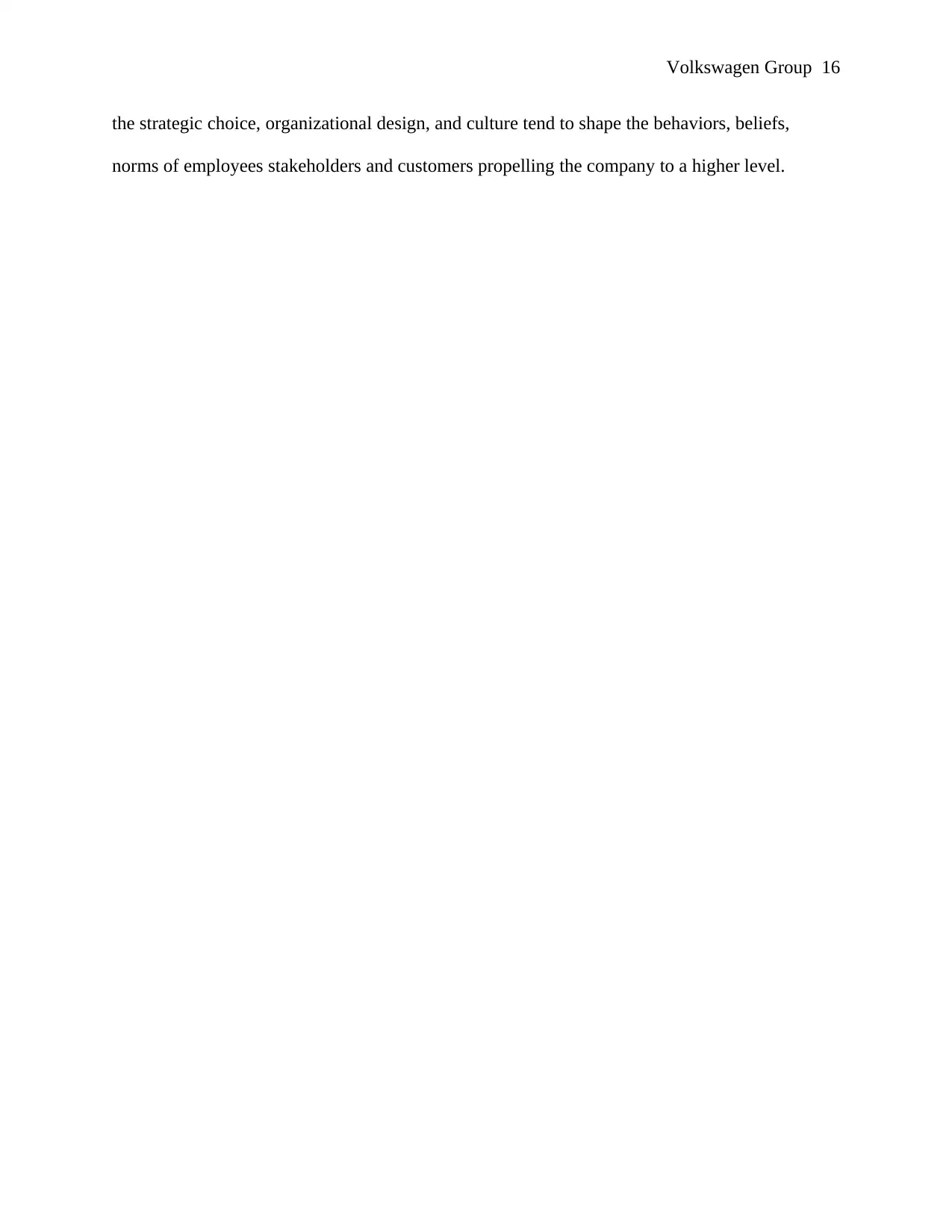
Volkswagen Group 16
the strategic choice, organizational design, and culture tend to shape the behaviors, beliefs,
norms of employees stakeholders and customers propelling the company to a higher level.
the strategic choice, organizational design, and culture tend to shape the behaviors, beliefs,
norms of employees stakeholders and customers propelling the company to a higher level.
Secure Best Marks with AI Grader
Need help grading? Try our AI Grader for instant feedback on your assignments.

Volkswagen Group 17
8.0.0 List of References
Altenburg, T, Schamp, E, & Chaudhary, A 2016, 'The emergence of electromobility: Comparing
technological pathways in France, Germany, China and India', Science & Public Policy
(SPP), 43, 4, pp. 464-475, Academic Search Premier, EBSCOhost, viewed 20 April
2018.
Bauer, R 2013, 'A specifically German path to mass motorisation? Motorcycles in Germany
between the World Wars', Journal Of Transport History, 34, 2, pp. 101-116, Academic
Search Premier, EBSCOhost, viewed 20 April 2018
Colovic, A, & Mayrhofer, U 2011, 'Optimizing the Location of R&D and Production Activities:
Trends in the Automotive Industry', European Planning Studies, 19, 8, pp. 1481-1498,
Academic Search Premier, EBSCOhost, viewed 20 April 2018.
Cudny, W, & Horňák, M 2016, 'The tourist function in a car factory Audi Forum Ingolstadt
example', Bulletin Of Geography. Socio-Economic Series, 33, 33, pp. 23-28, Academic
Search Premier, EBSCOhost, viewed 20 April 2018.
Danesi, M 2013, 'Semiotizing a product into a brand', Social Semiotics, 23, 4, pp. 464-476,
Academic Search Premier, EBSCOhost, viewed 20 April 2018.
De, D 2011, 'Regional trade and international production networks: The context of automobile
industry in Asia', International Journal of Technology Management & Sustainable
Development, vol. 10, no. 1, pp. 77-98.
8.0.0 List of References
Altenburg, T, Schamp, E, & Chaudhary, A 2016, 'The emergence of electromobility: Comparing
technological pathways in France, Germany, China and India', Science & Public Policy
(SPP), 43, 4, pp. 464-475, Academic Search Premier, EBSCOhost, viewed 20 April
2018.
Bauer, R 2013, 'A specifically German path to mass motorisation? Motorcycles in Germany
between the World Wars', Journal Of Transport History, 34, 2, pp. 101-116, Academic
Search Premier, EBSCOhost, viewed 20 April 2018
Colovic, A, & Mayrhofer, U 2011, 'Optimizing the Location of R&D and Production Activities:
Trends in the Automotive Industry', European Planning Studies, 19, 8, pp. 1481-1498,
Academic Search Premier, EBSCOhost, viewed 20 April 2018.
Cudny, W, & Horňák, M 2016, 'The tourist function in a car factory Audi Forum Ingolstadt
example', Bulletin Of Geography. Socio-Economic Series, 33, 33, pp. 23-28, Academic
Search Premier, EBSCOhost, viewed 20 April 2018.
Danesi, M 2013, 'Semiotizing a product into a brand', Social Semiotics, 23, 4, pp. 464-476,
Academic Search Premier, EBSCOhost, viewed 20 April 2018.
De, D 2011, 'Regional trade and international production networks: The context of automobile
industry in Asia', International Journal of Technology Management & Sustainable
Development, vol. 10, no. 1, pp. 77-98.
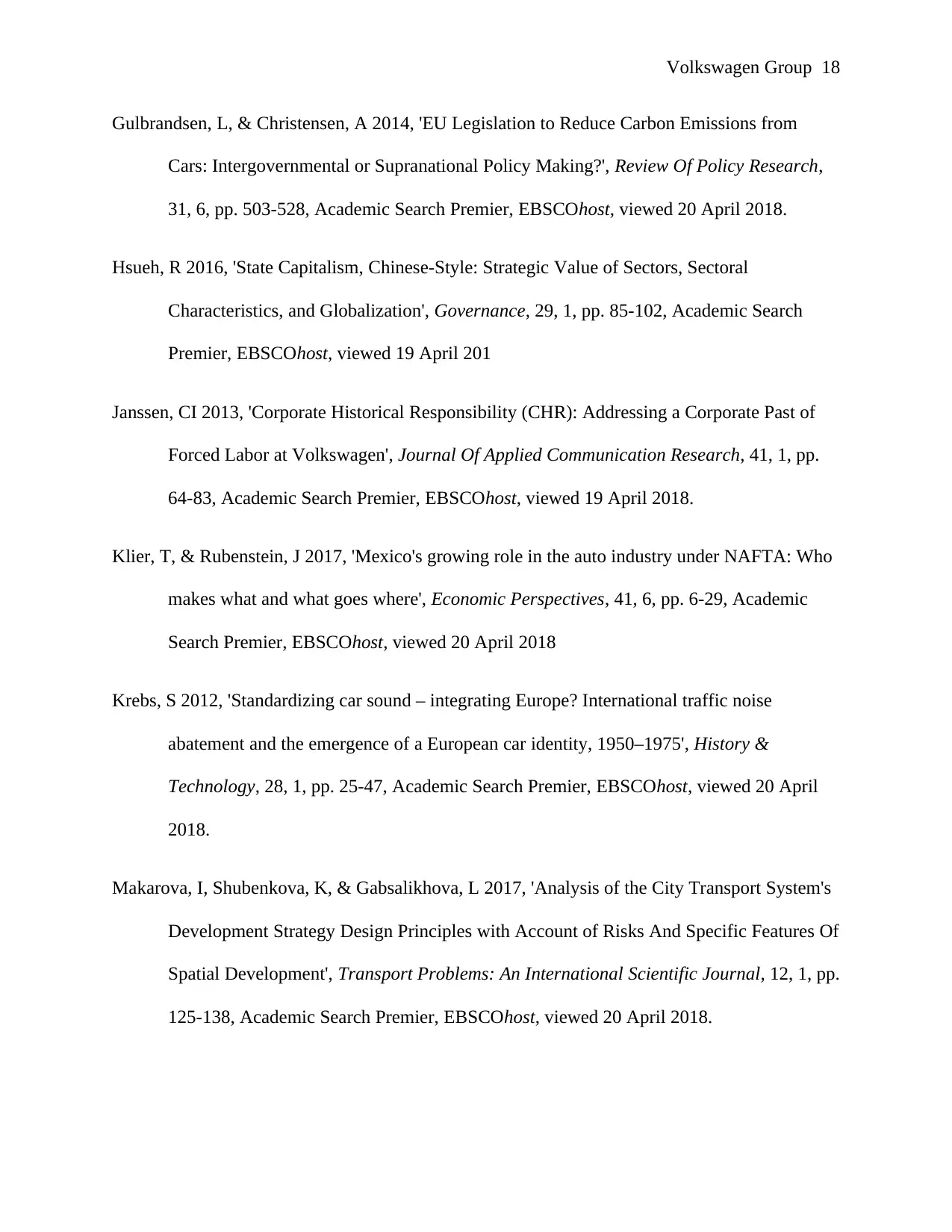
Volkswagen Group 18
Gulbrandsen, L, & Christensen, A 2014, 'EU Legislation to Reduce Carbon Emissions from
Cars: Intergovernmental or Supranational Policy Making?', Review Of Policy Research,
31, 6, pp. 503-528, Academic Search Premier, EBSCOhost, viewed 20 April 2018.
Hsueh, R 2016, 'State Capitalism, Chinese-Style: Strategic Value of Sectors, Sectoral
Characteristics, and Globalization', Governance, 29, 1, pp. 85-102, Academic Search
Premier, EBSCOhost, viewed 19 April 201
Janssen, CI 2013, 'Corporate Historical Responsibility (CHR): Addressing a Corporate Past of
Forced Labor at Volkswagen', Journal Of Applied Communication Research, 41, 1, pp.
64-83, Academic Search Premier, EBSCOhost, viewed 19 April 2018.
Klier, T, & Rubenstein, J 2017, 'Mexico's growing role in the auto industry under NAFTA: Who
makes what and what goes where', Economic Perspectives, 41, 6, pp. 6-29, Academic
Search Premier, EBSCOhost, viewed 20 April 2018
Krebs, S 2012, 'Standardizing car sound – integrating Europe? International traffic noise
abatement and the emergence of a European car identity, 1950–1975', History &
Technology, 28, 1, pp. 25-47, Academic Search Premier, EBSCOhost, viewed 20 April
2018.
Makarova, I, Shubenkova, K, & Gabsalikhova, L 2017, 'Analysis of the City Transport System's
Development Strategy Design Principles with Account of Risks And Specific Features Of
Spatial Development', Transport Problems: An International Scientific Journal, 12, 1, pp.
125-138, Academic Search Premier, EBSCOhost, viewed 20 April 2018.
Gulbrandsen, L, & Christensen, A 2014, 'EU Legislation to Reduce Carbon Emissions from
Cars: Intergovernmental or Supranational Policy Making?', Review Of Policy Research,
31, 6, pp. 503-528, Academic Search Premier, EBSCOhost, viewed 20 April 2018.
Hsueh, R 2016, 'State Capitalism, Chinese-Style: Strategic Value of Sectors, Sectoral
Characteristics, and Globalization', Governance, 29, 1, pp. 85-102, Academic Search
Premier, EBSCOhost, viewed 19 April 201
Janssen, CI 2013, 'Corporate Historical Responsibility (CHR): Addressing a Corporate Past of
Forced Labor at Volkswagen', Journal Of Applied Communication Research, 41, 1, pp.
64-83, Academic Search Premier, EBSCOhost, viewed 19 April 2018.
Klier, T, & Rubenstein, J 2017, 'Mexico's growing role in the auto industry under NAFTA: Who
makes what and what goes where', Economic Perspectives, 41, 6, pp. 6-29, Academic
Search Premier, EBSCOhost, viewed 20 April 2018
Krebs, S 2012, 'Standardizing car sound – integrating Europe? International traffic noise
abatement and the emergence of a European car identity, 1950–1975', History &
Technology, 28, 1, pp. 25-47, Academic Search Premier, EBSCOhost, viewed 20 April
2018.
Makarova, I, Shubenkova, K, & Gabsalikhova, L 2017, 'Analysis of the City Transport System's
Development Strategy Design Principles with Account of Risks And Specific Features Of
Spatial Development', Transport Problems: An International Scientific Journal, 12, 1, pp.
125-138, Academic Search Premier, EBSCOhost, viewed 20 April 2018.
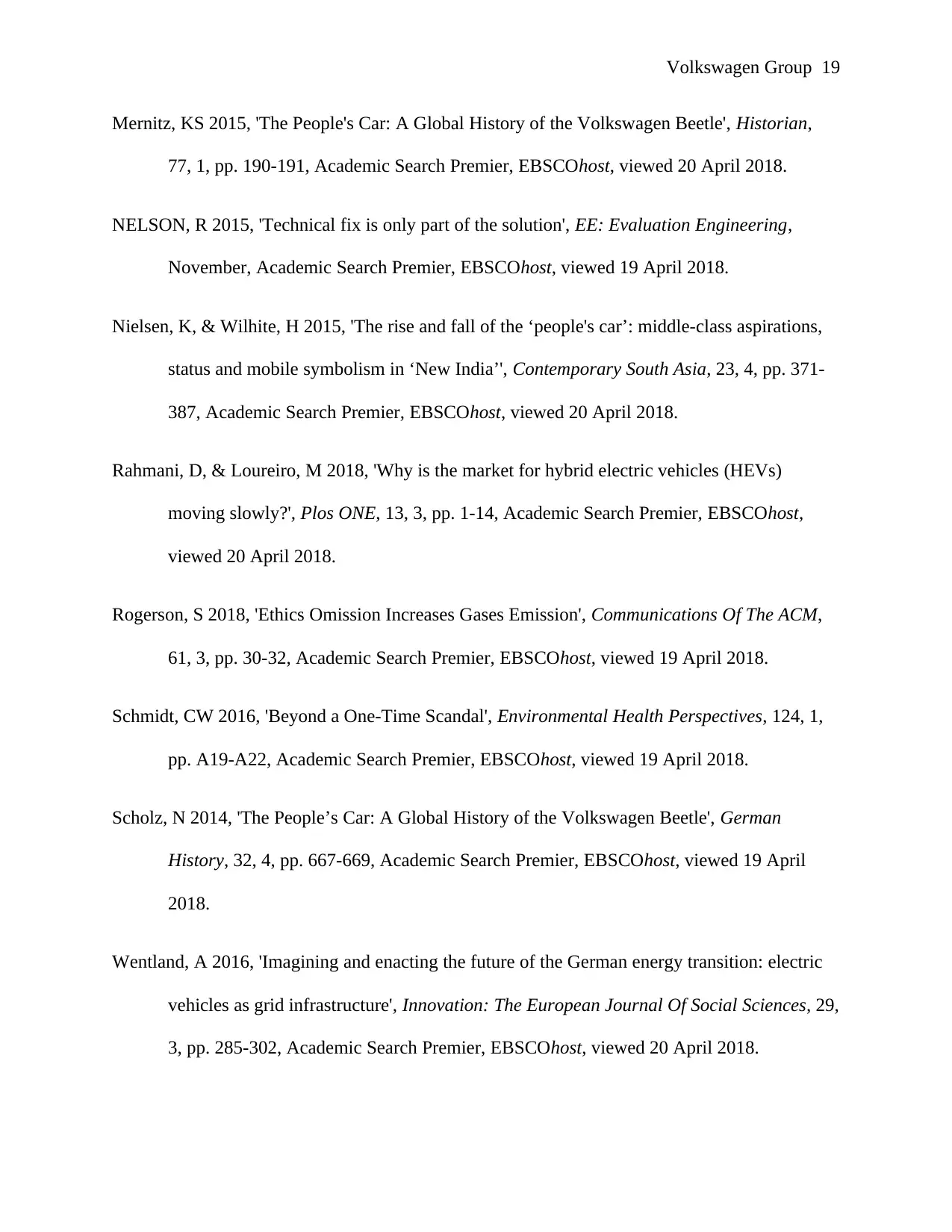
Volkswagen Group 19
Mernitz, KS 2015, 'The People's Car: A Global History of the Volkswagen Beetle', Historian,
77, 1, pp. 190-191, Academic Search Premier, EBSCOhost, viewed 20 April 2018.
NELSON, R 2015, 'Technical fix is only part of the solution', EE: Evaluation Engineering,
November, Academic Search Premier, EBSCOhost, viewed 19 April 2018.
Nielsen, K, & Wilhite, H 2015, 'The rise and fall of the ‘people's car’: middle-class aspirations,
status and mobile symbolism in ‘New India’', Contemporary South Asia, 23, 4, pp. 371-
387, Academic Search Premier, EBSCOhost, viewed 20 April 2018.
Rahmani, D, & Loureiro, M 2018, 'Why is the market for hybrid electric vehicles (HEVs)
moving slowly?', Plos ONE, 13, 3, pp. 1-14, Academic Search Premier, EBSCOhost,
viewed 20 April 2018.
Rogerson, S 2018, 'Ethics Omission Increases Gases Emission', Communications Of The ACM,
61, 3, pp. 30-32, Academic Search Premier, EBSCOhost, viewed 19 April 2018.
Schmidt, CW 2016, 'Beyond a One-Time Scandal', Environmental Health Perspectives, 124, 1,
pp. A19-A22, Academic Search Premier, EBSCOhost, viewed 19 April 2018.
Scholz, N 2014, 'The People’s Car: A Global History of the Volkswagen Beetle', German
History, 32, 4, pp. 667-669, Academic Search Premier, EBSCOhost, viewed 19 April
2018.
Wentland, A 2016, 'Imagining and enacting the future of the German energy transition: electric
vehicles as grid infrastructure', Innovation: The European Journal Of Social Sciences, 29,
3, pp. 285-302, Academic Search Premier, EBSCOhost, viewed 20 April 2018.
Mernitz, KS 2015, 'The People's Car: A Global History of the Volkswagen Beetle', Historian,
77, 1, pp. 190-191, Academic Search Premier, EBSCOhost, viewed 20 April 2018.
NELSON, R 2015, 'Technical fix is only part of the solution', EE: Evaluation Engineering,
November, Academic Search Premier, EBSCOhost, viewed 19 April 2018.
Nielsen, K, & Wilhite, H 2015, 'The rise and fall of the ‘people's car’: middle-class aspirations,
status and mobile symbolism in ‘New India’', Contemporary South Asia, 23, 4, pp. 371-
387, Academic Search Premier, EBSCOhost, viewed 20 April 2018.
Rahmani, D, & Loureiro, M 2018, 'Why is the market for hybrid electric vehicles (HEVs)
moving slowly?', Plos ONE, 13, 3, pp. 1-14, Academic Search Premier, EBSCOhost,
viewed 20 April 2018.
Rogerson, S 2018, 'Ethics Omission Increases Gases Emission', Communications Of The ACM,
61, 3, pp. 30-32, Academic Search Premier, EBSCOhost, viewed 19 April 2018.
Schmidt, CW 2016, 'Beyond a One-Time Scandal', Environmental Health Perspectives, 124, 1,
pp. A19-A22, Academic Search Premier, EBSCOhost, viewed 19 April 2018.
Scholz, N 2014, 'The People’s Car: A Global History of the Volkswagen Beetle', German
History, 32, 4, pp. 667-669, Academic Search Premier, EBSCOhost, viewed 19 April
2018.
Wentland, A 2016, 'Imagining and enacting the future of the German energy transition: electric
vehicles as grid infrastructure', Innovation: The European Journal Of Social Sciences, 29,
3, pp. 285-302, Academic Search Premier, EBSCOhost, viewed 20 April 2018.
Paraphrase This Document
Need a fresh take? Get an instant paraphrase of this document with our AI Paraphraser
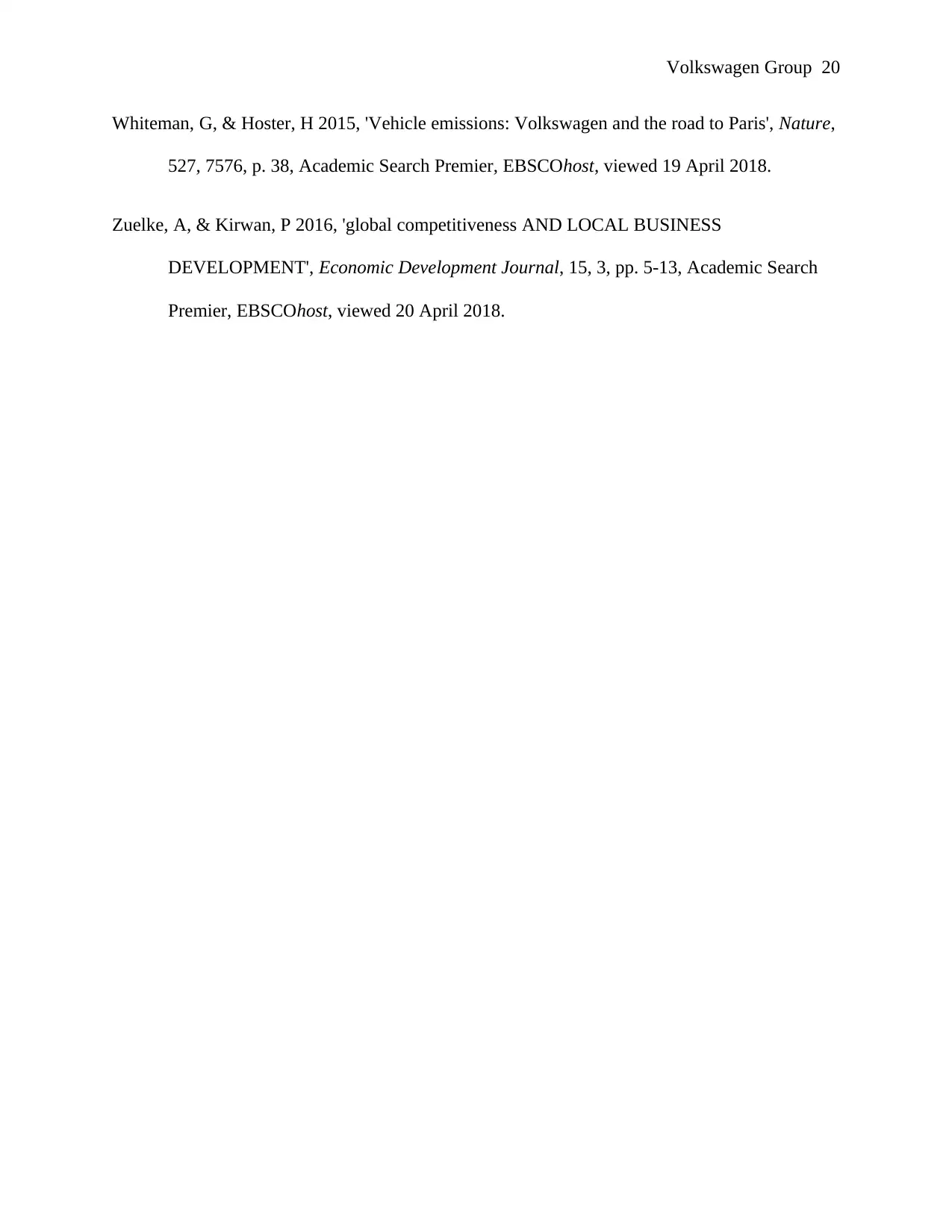
Volkswagen Group 20
Whiteman, G, & Hoster, H 2015, 'Vehicle emissions: Volkswagen and the road to Paris', Nature,
527, 7576, p. 38, Academic Search Premier, EBSCOhost, viewed 19 April 2018.
Zuelke, A, & Kirwan, P 2016, 'global competitiveness AND LOCAL BUSINESS
DEVELOPMENT', Economic Development Journal, 15, 3, pp. 5-13, Academic Search
Premier, EBSCOhost, viewed 20 April 2018.
Whiteman, G, & Hoster, H 2015, 'Vehicle emissions: Volkswagen and the road to Paris', Nature,
527, 7576, p. 38, Academic Search Premier, EBSCOhost, viewed 19 April 2018.
Zuelke, A, & Kirwan, P 2016, 'global competitiveness AND LOCAL BUSINESS
DEVELOPMENT', Economic Development Journal, 15, 3, pp. 5-13, Academic Search
Premier, EBSCOhost, viewed 20 April 2018.

Volkswagen Group 21
9.0.0 Appendices
Figure 1shows the positive growth of the company's revenue
Figure 2 shows global market share of VWG
Figure 4 shows the global market share of the major automobile companies
9.0.0 Appendices
Figure 1shows the positive growth of the company's revenue
Figure 2 shows global market share of VWG
Figure 4 shows the global market share of the major automobile companies
1 out of 21
Your All-in-One AI-Powered Toolkit for Academic Success.
+13062052269
info@desklib.com
Available 24*7 on WhatsApp / Email
![[object Object]](/_next/static/media/star-bottom.7253800d.svg)
Unlock your academic potential
© 2024 | Zucol Services PVT LTD | All rights reserved.

